Impact of Employee Collaboration Tools in UK Retail Industry: A Study on Asda
VerifiedAdded on 2023/06/08
|23
|4638
|81
AI Summary
This research project aims to determine the impact of employee collaboration tools in increasing the productivity and its contribution in workplace transformation within UK retail industry. The study is conducted on Asda, a British supermarket chain. The benefits, challenges, and requirements of employee collaboration tools are analyzed through a literature review and a survey of 30 managers. The findings suggest that employee collaboration tools have a positive impact on employee performance and productivity, and Asda has gained benefits such as high employee performance and improved communication system after implementing these tools.
Contribute Materials
Your contribution can guide someone’s learning journey. Share your
documents today.
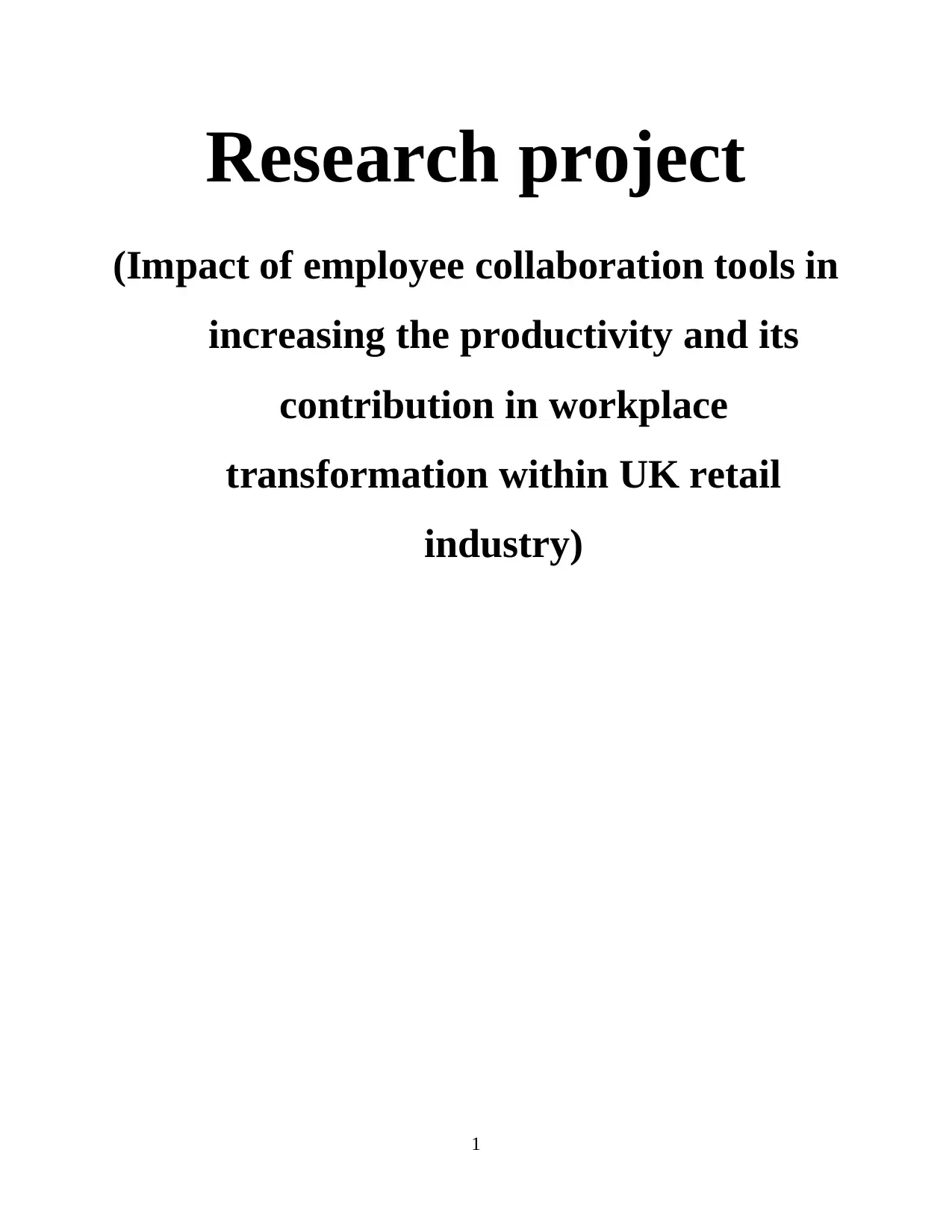
Research project
(Impact of employee collaboration tools in
increasing the productivity and its
contribution in workplace
transformation within UK retail
industry)
1
(Impact of employee collaboration tools in
increasing the productivity and its
contribution in workplace
transformation within UK retail
industry)
1
Secure Best Marks with AI Grader
Need help grading? Try our AI Grader for instant feedback on your assignments.
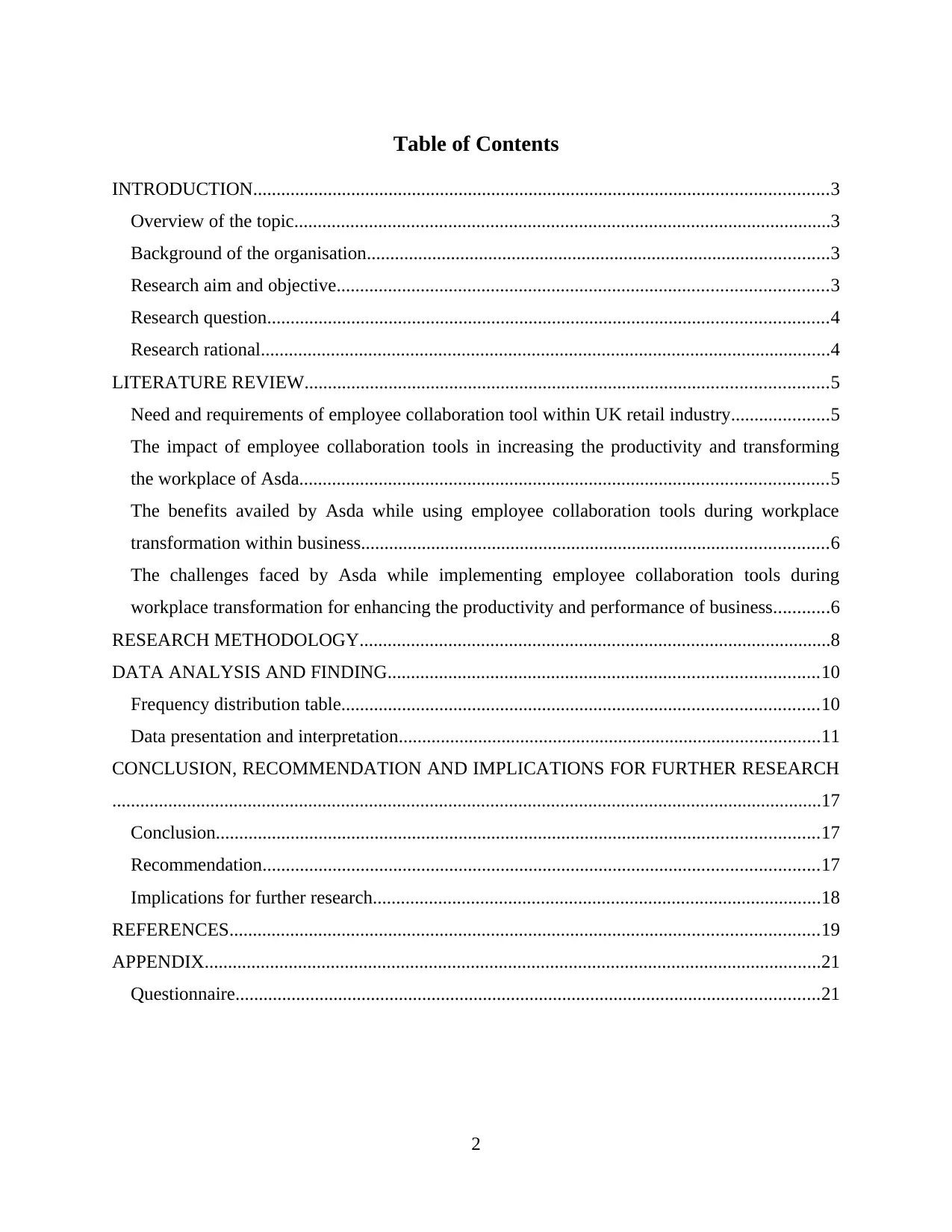
Table of Contents
INTRODUCTION...........................................................................................................................3
Overview of the topic...................................................................................................................3
Background of the organisation...................................................................................................3
Research aim and objective.........................................................................................................3
Research question........................................................................................................................4
Research rational..........................................................................................................................4
LITERATURE REVIEW................................................................................................................5
Need and requirements of employee collaboration tool within UK retail industry.....................5
The impact of employee collaboration tools in increasing the productivity and transforming
the workplace of Asda.................................................................................................................5
The benefits availed by Asda while using employee collaboration tools during workplace
transformation within business....................................................................................................6
The challenges faced by Asda while implementing employee collaboration tools during
workplace transformation for enhancing the productivity and performance of business............6
RESEARCH METHODOLOGY.....................................................................................................8
DATA ANALYSIS AND FINDING............................................................................................10
Frequency distribution table......................................................................................................10
Data presentation and interpretation..........................................................................................11
CONCLUSION, RECOMMENDATION AND IMPLICATIONS FOR FURTHER RESEARCH
........................................................................................................................................................17
Conclusion.................................................................................................................................17
Recommendation.......................................................................................................................17
Implications for further research................................................................................................18
REFERENCES..............................................................................................................................19
APPENDIX....................................................................................................................................21
Questionnaire.............................................................................................................................21
2
INTRODUCTION...........................................................................................................................3
Overview of the topic...................................................................................................................3
Background of the organisation...................................................................................................3
Research aim and objective.........................................................................................................3
Research question........................................................................................................................4
Research rational..........................................................................................................................4
LITERATURE REVIEW................................................................................................................5
Need and requirements of employee collaboration tool within UK retail industry.....................5
The impact of employee collaboration tools in increasing the productivity and transforming
the workplace of Asda.................................................................................................................5
The benefits availed by Asda while using employee collaboration tools during workplace
transformation within business....................................................................................................6
The challenges faced by Asda while implementing employee collaboration tools during
workplace transformation for enhancing the productivity and performance of business............6
RESEARCH METHODOLOGY.....................................................................................................8
DATA ANALYSIS AND FINDING............................................................................................10
Frequency distribution table......................................................................................................10
Data presentation and interpretation..........................................................................................11
CONCLUSION, RECOMMENDATION AND IMPLICATIONS FOR FURTHER RESEARCH
........................................................................................................................................................17
Conclusion.................................................................................................................................17
Recommendation.......................................................................................................................17
Implications for further research................................................................................................18
REFERENCES..............................................................................................................................19
APPENDIX....................................................................................................................................21
Questionnaire.............................................................................................................................21
2
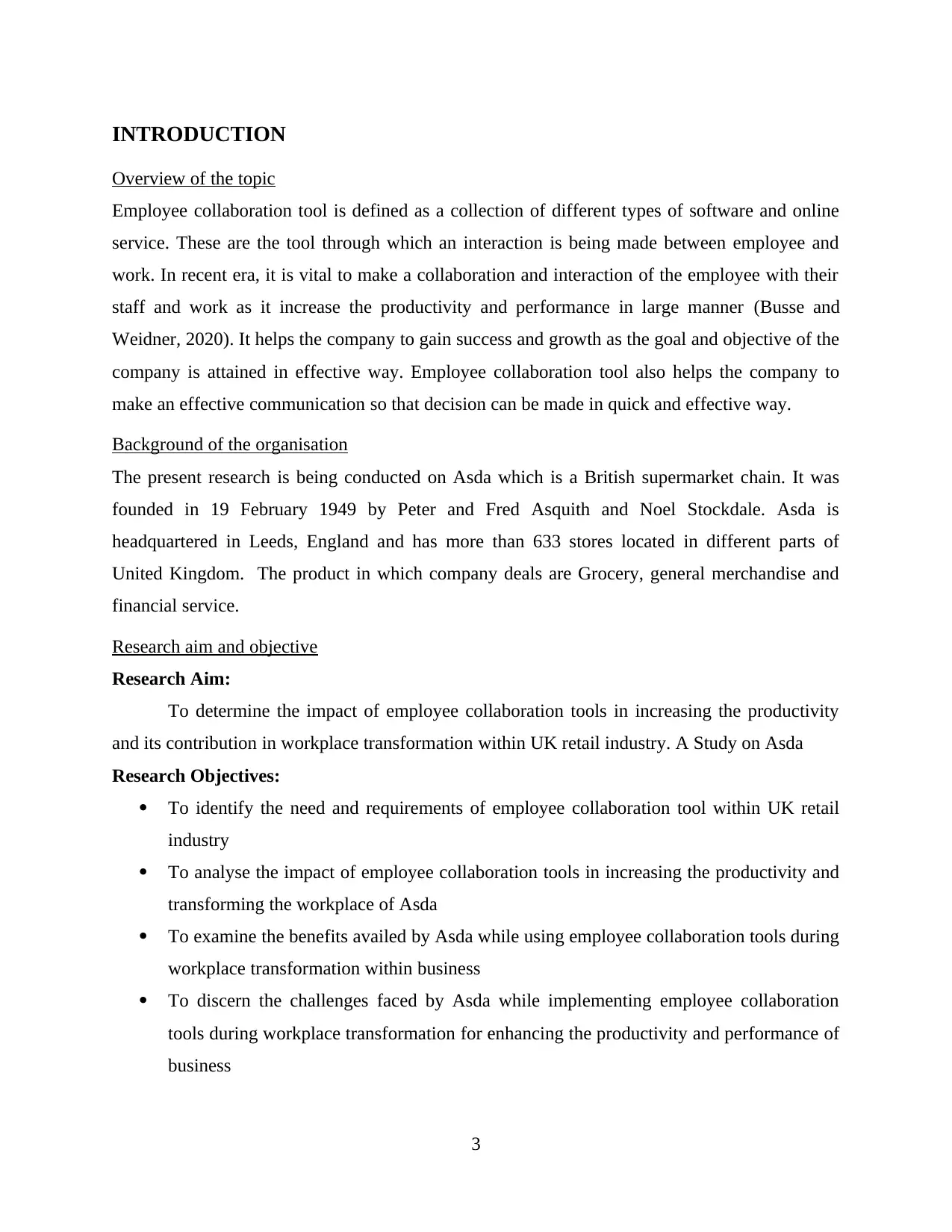
INTRODUCTION
Overview of the topic
Employee collaboration tool is defined as a collection of different types of software and online
service. These are the tool through which an interaction is being made between employee and
work. In recent era, it is vital to make a collaboration and interaction of the employee with their
staff and work as it increase the productivity and performance in large manner (Busse and
Weidner, 2020). It helps the company to gain success and growth as the goal and objective of the
company is attained in effective way. Employee collaboration tool also helps the company to
make an effective communication so that decision can be made in quick and effective way.
Background of the organisation
The present research is being conducted on Asda which is a British supermarket chain. It was
founded in 19 February 1949 by Peter and Fred Asquith and Noel Stockdale. Asda is
headquartered in Leeds, England and has more than 633 stores located in different parts of
United Kingdom. The product in which company deals are Grocery, general merchandise and
financial service.
Research aim and objective
Research Aim:
To determine the impact of employee collaboration tools in increasing the productivity
and its contribution in workplace transformation within UK retail industry. A Study on Asda
Research Objectives:
To identify the need and requirements of employee collaboration tool within UK retail
industry
To analyse the impact of employee collaboration tools in increasing the productivity and
transforming the workplace of Asda
To examine the benefits availed by Asda while using employee collaboration tools during
workplace transformation within business
To discern the challenges faced by Asda while implementing employee collaboration
tools during workplace transformation for enhancing the productivity and performance of
business
3
Overview of the topic
Employee collaboration tool is defined as a collection of different types of software and online
service. These are the tool through which an interaction is being made between employee and
work. In recent era, it is vital to make a collaboration and interaction of the employee with their
staff and work as it increase the productivity and performance in large manner (Busse and
Weidner, 2020). It helps the company to gain success and growth as the goal and objective of the
company is attained in effective way. Employee collaboration tool also helps the company to
make an effective communication so that decision can be made in quick and effective way.
Background of the organisation
The present research is being conducted on Asda which is a British supermarket chain. It was
founded in 19 February 1949 by Peter and Fred Asquith and Noel Stockdale. Asda is
headquartered in Leeds, England and has more than 633 stores located in different parts of
United Kingdom. The product in which company deals are Grocery, general merchandise and
financial service.
Research aim and objective
Research Aim:
To determine the impact of employee collaboration tools in increasing the productivity
and its contribution in workplace transformation within UK retail industry. A Study on Asda
Research Objectives:
To identify the need and requirements of employee collaboration tool within UK retail
industry
To analyse the impact of employee collaboration tools in increasing the productivity and
transforming the workplace of Asda
To examine the benefits availed by Asda while using employee collaboration tools during
workplace transformation within business
To discern the challenges faced by Asda while implementing employee collaboration
tools during workplace transformation for enhancing the productivity and performance of
business
3
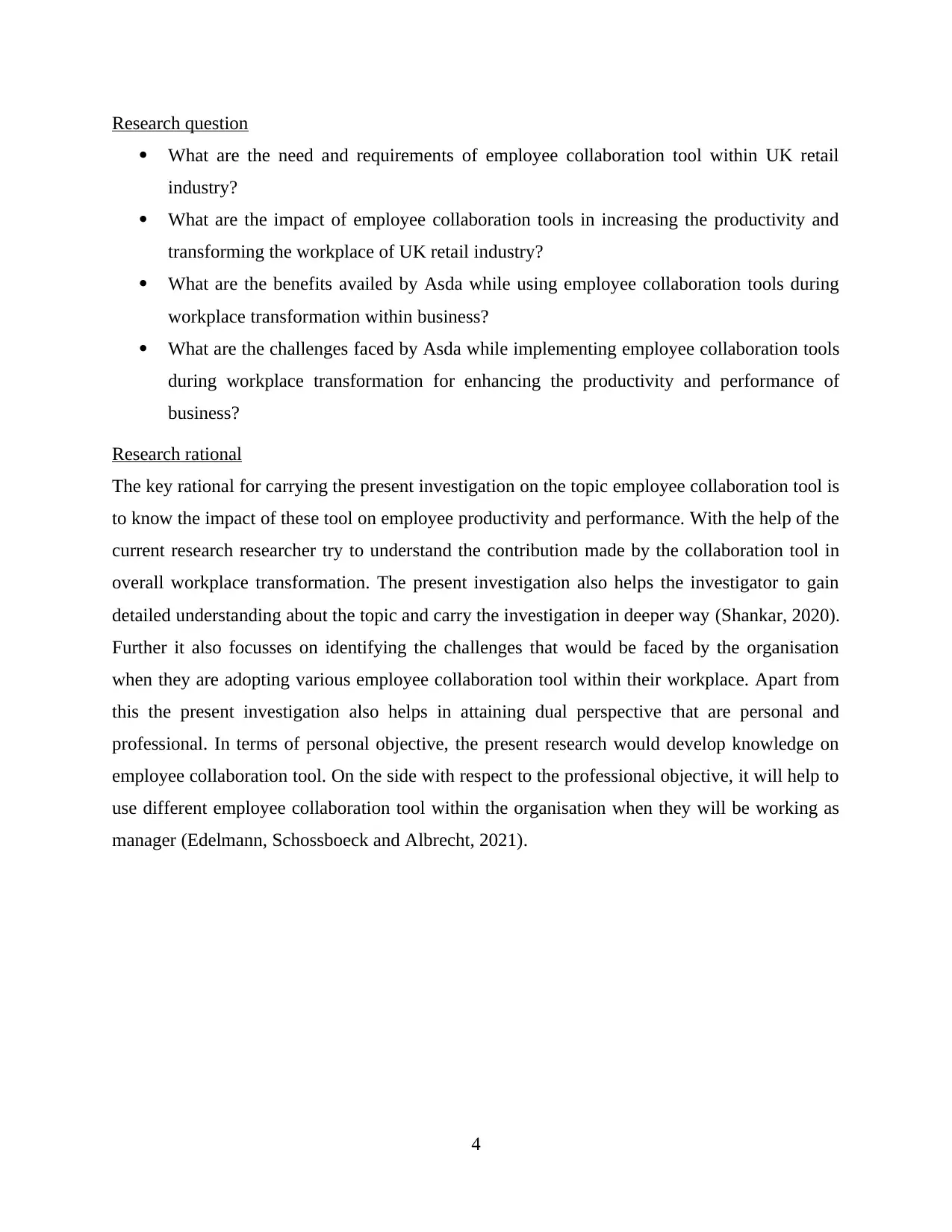
Research question
What are the need and requirements of employee collaboration tool within UK retail
industry?
What are the impact of employee collaboration tools in increasing the productivity and
transforming the workplace of UK retail industry?
What are the benefits availed by Asda while using employee collaboration tools during
workplace transformation within business?
What are the challenges faced by Asda while implementing employee collaboration tools
during workplace transformation for enhancing the productivity and performance of
business?
Research rational
The key rational for carrying the present investigation on the topic employee collaboration tool is
to know the impact of these tool on employee productivity and performance. With the help of the
current research researcher try to understand the contribution made by the collaboration tool in
overall workplace transformation. The present investigation also helps the investigator to gain
detailed understanding about the topic and carry the investigation in deeper way (Shankar, 2020).
Further it also focusses on identifying the challenges that would be faced by the organisation
when they are adopting various employee collaboration tool within their workplace. Apart from
this the present investigation also helps in attaining dual perspective that are personal and
professional. In terms of personal objective, the present research would develop knowledge on
employee collaboration tool. On the side with respect to the professional objective, it will help to
use different employee collaboration tool within the organisation when they will be working as
manager (Edelmann, Schossboeck and Albrecht, 2021).
4
What are the need and requirements of employee collaboration tool within UK retail
industry?
What are the impact of employee collaboration tools in increasing the productivity and
transforming the workplace of UK retail industry?
What are the benefits availed by Asda while using employee collaboration tools during
workplace transformation within business?
What are the challenges faced by Asda while implementing employee collaboration tools
during workplace transformation for enhancing the productivity and performance of
business?
Research rational
The key rational for carrying the present investigation on the topic employee collaboration tool is
to know the impact of these tool on employee productivity and performance. With the help of the
current research researcher try to understand the contribution made by the collaboration tool in
overall workplace transformation. The present investigation also helps the investigator to gain
detailed understanding about the topic and carry the investigation in deeper way (Shankar, 2020).
Further it also focusses on identifying the challenges that would be faced by the organisation
when they are adopting various employee collaboration tool within their workplace. Apart from
this the present investigation also helps in attaining dual perspective that are personal and
professional. In terms of personal objective, the present research would develop knowledge on
employee collaboration tool. On the side with respect to the professional objective, it will help to
use different employee collaboration tool within the organisation when they will be working as
manager (Edelmann, Schossboeck and Albrecht, 2021).
4
Secure Best Marks with AI Grader
Need help grading? Try our AI Grader for instant feedback on your assignments.
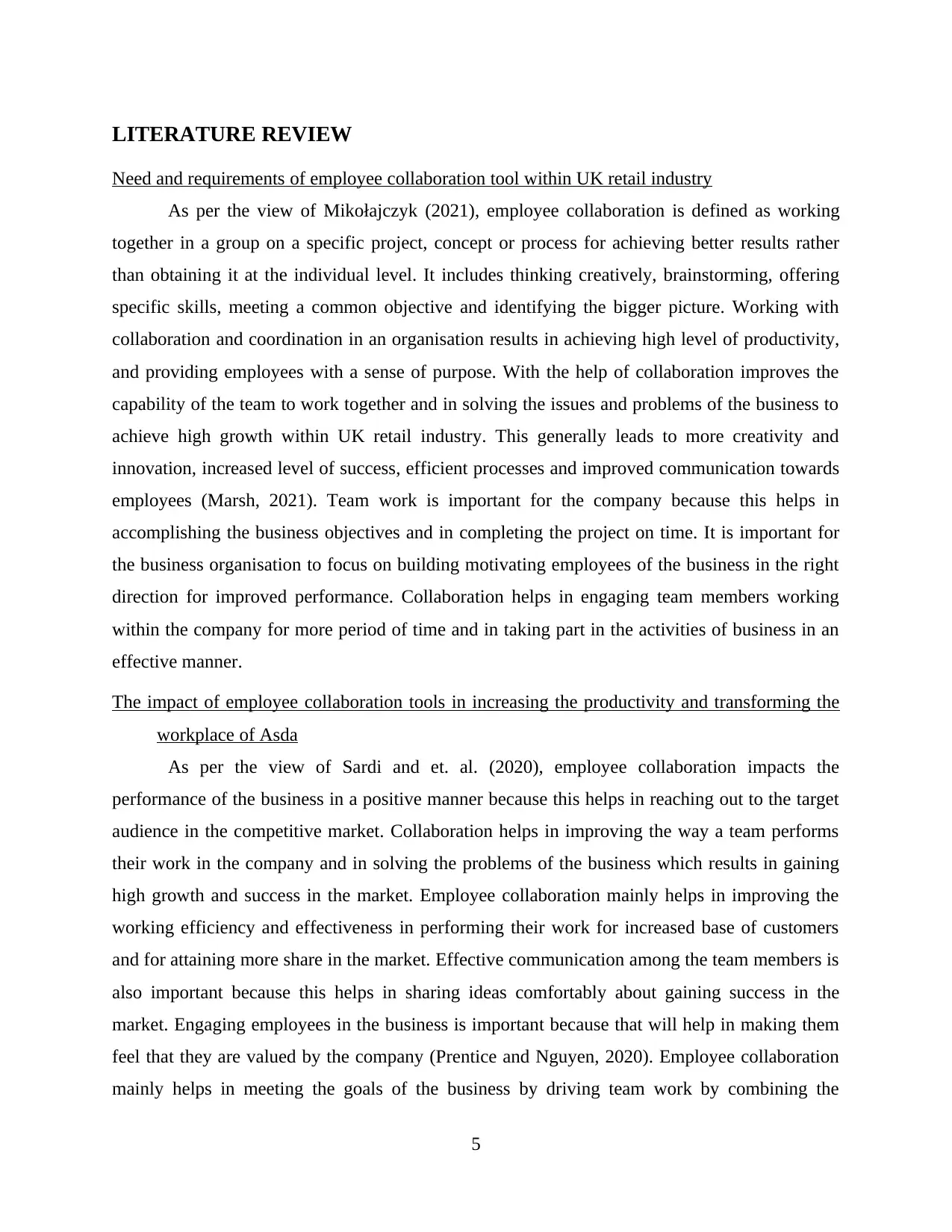
LITERATURE REVIEW
Need and requirements of employee collaboration tool within UK retail industry
As per the view of Mikołajczyk (2021), employee collaboration is defined as working
together in a group on a specific project, concept or process for achieving better results rather
than obtaining it at the individual level. It includes thinking creatively, brainstorming, offering
specific skills, meeting a common objective and identifying the bigger picture. Working with
collaboration and coordination in an organisation results in achieving high level of productivity,
and providing employees with a sense of purpose. With the help of collaboration improves the
capability of the team to work together and in solving the issues and problems of the business to
achieve high growth within UK retail industry. This generally leads to more creativity and
innovation, increased level of success, efficient processes and improved communication towards
employees (Marsh, 2021). Team work is important for the company because this helps in
accomplishing the business objectives and in completing the project on time. It is important for
the business organisation to focus on building motivating employees of the business in the right
direction for improved performance. Collaboration helps in engaging team members working
within the company for more period of time and in taking part in the activities of business in an
effective manner.
The impact of employee collaboration tools in increasing the productivity and transforming the
workplace of Asda
As per the view of Sardi and et. al. (2020), employee collaboration impacts the
performance of the business in a positive manner because this helps in reaching out to the target
audience in the competitive market. Collaboration helps in improving the way a team performs
their work in the company and in solving the problems of the business which results in gaining
high growth and success in the market. Employee collaboration mainly helps in improving the
working efficiency and effectiveness in performing their work for increased base of customers
and for attaining more share in the market. Effective communication among the team members is
also important because this helps in sharing ideas comfortably about gaining success in the
market. Engaging employees in the business is important because that will help in making them
feel that they are valued by the company (Prentice and Nguyen, 2020). Employee collaboration
mainly helps in meeting the goals of the business by driving team work by combining the
5
Need and requirements of employee collaboration tool within UK retail industry
As per the view of Mikołajczyk (2021), employee collaboration is defined as working
together in a group on a specific project, concept or process for achieving better results rather
than obtaining it at the individual level. It includes thinking creatively, brainstorming, offering
specific skills, meeting a common objective and identifying the bigger picture. Working with
collaboration and coordination in an organisation results in achieving high level of productivity,
and providing employees with a sense of purpose. With the help of collaboration improves the
capability of the team to work together and in solving the issues and problems of the business to
achieve high growth within UK retail industry. This generally leads to more creativity and
innovation, increased level of success, efficient processes and improved communication towards
employees (Marsh, 2021). Team work is important for the company because this helps in
accomplishing the business objectives and in completing the project on time. It is important for
the business organisation to focus on building motivating employees of the business in the right
direction for improved performance. Collaboration helps in engaging team members working
within the company for more period of time and in taking part in the activities of business in an
effective manner.
The impact of employee collaboration tools in increasing the productivity and transforming the
workplace of Asda
As per the view of Sardi and et. al. (2020), employee collaboration impacts the
performance of the business in a positive manner because this helps in reaching out to the target
audience in the competitive market. Collaboration helps in improving the way a team performs
their work in the company and in solving the problems of the business which results in gaining
high growth and success in the market. Employee collaboration mainly helps in improving the
working efficiency and effectiveness in performing their work for increased base of customers
and for attaining more share in the market. Effective communication among the team members is
also important because this helps in sharing ideas comfortably about gaining success in the
market. Engaging employees in the business is important because that will help in making them
feel that they are valued by the company (Prentice and Nguyen, 2020). Employee collaboration
mainly helps in meeting the goals of the business by driving team work by combining the
5
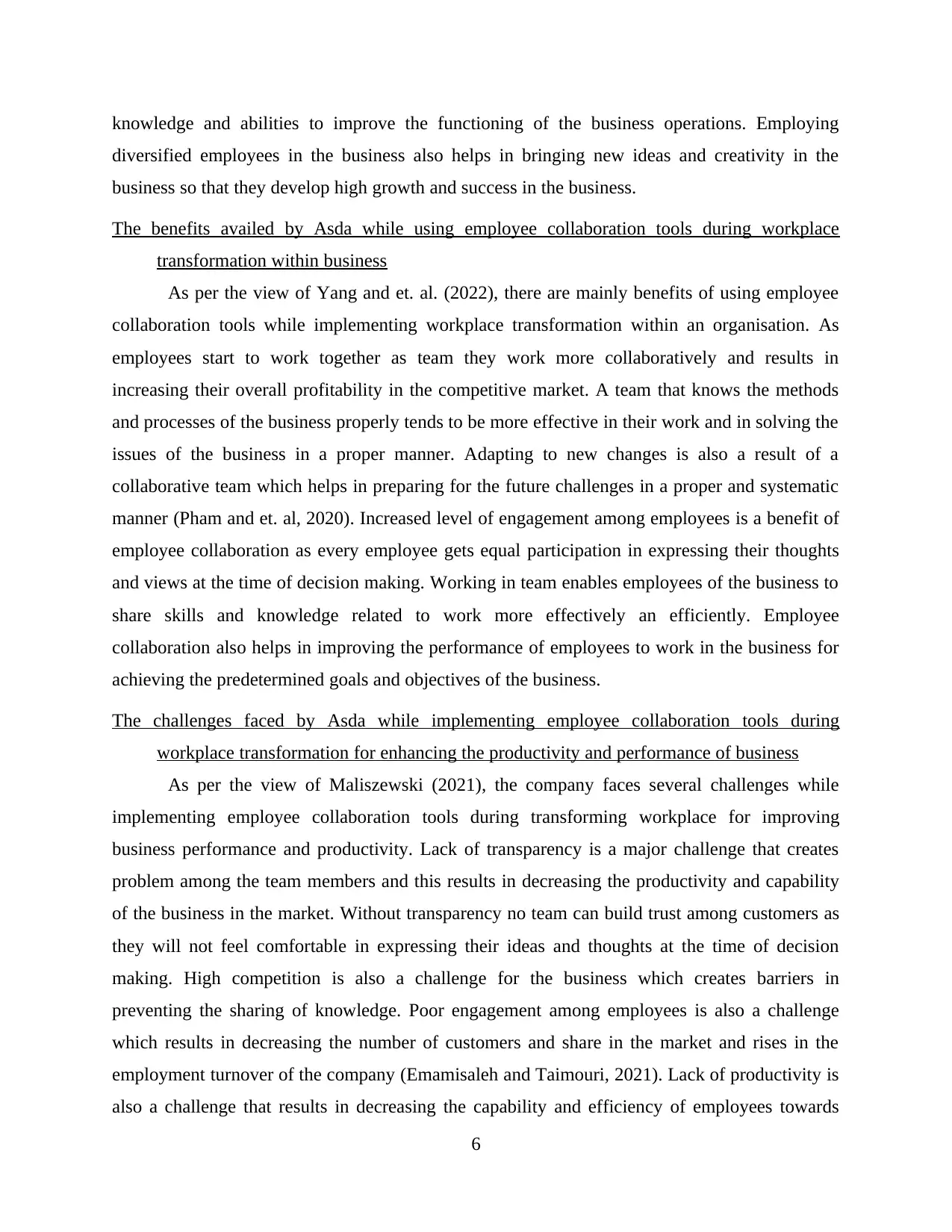
knowledge and abilities to improve the functioning of the business operations. Employing
diversified employees in the business also helps in bringing new ideas and creativity in the
business so that they develop high growth and success in the business.
The benefits availed by Asda while using employee collaboration tools during workplace
transformation within business
As per the view of Yang and et. al. (2022), there are mainly benefits of using employee
collaboration tools while implementing workplace transformation within an organisation. As
employees start to work together as team they work more collaboratively and results in
increasing their overall profitability in the competitive market. A team that knows the methods
and processes of the business properly tends to be more effective in their work and in solving the
issues of the business in a proper manner. Adapting to new changes is also a result of a
collaborative team which helps in preparing for the future challenges in a proper and systematic
manner (Pham and et. al, 2020). Increased level of engagement among employees is a benefit of
employee collaboration as every employee gets equal participation in expressing their thoughts
and views at the time of decision making. Working in team enables employees of the business to
share skills and knowledge related to work more effectively an efficiently. Employee
collaboration also helps in improving the performance of employees to work in the business for
achieving the predetermined goals and objectives of the business.
The challenges faced by Asda while implementing employee collaboration tools during
workplace transformation for enhancing the productivity and performance of business
As per the view of Maliszewski (2021), the company faces several challenges while
implementing employee collaboration tools during transforming workplace for improving
business performance and productivity. Lack of transparency is a major challenge that creates
problem among the team members and this results in decreasing the productivity and capability
of the business in the market. Without transparency no team can build trust among customers as
they will not feel comfortable in expressing their ideas and thoughts at the time of decision
making. High competition is also a challenge for the business which creates barriers in
preventing the sharing of knowledge. Poor engagement among employees is also a challenge
which results in decreasing the number of customers and share in the market and rises in the
employment turnover of the company (Emamisaleh and Taimouri, 2021). Lack of productivity is
also a challenge that results in decreasing the capability and efficiency of employees towards
6
diversified employees in the business also helps in bringing new ideas and creativity in the
business so that they develop high growth and success in the business.
The benefits availed by Asda while using employee collaboration tools during workplace
transformation within business
As per the view of Yang and et. al. (2022), there are mainly benefits of using employee
collaboration tools while implementing workplace transformation within an organisation. As
employees start to work together as team they work more collaboratively and results in
increasing their overall profitability in the competitive market. A team that knows the methods
and processes of the business properly tends to be more effective in their work and in solving the
issues of the business in a proper manner. Adapting to new changes is also a result of a
collaborative team which helps in preparing for the future challenges in a proper and systematic
manner (Pham and et. al, 2020). Increased level of engagement among employees is a benefit of
employee collaboration as every employee gets equal participation in expressing their thoughts
and views at the time of decision making. Working in team enables employees of the business to
share skills and knowledge related to work more effectively an efficiently. Employee
collaboration also helps in improving the performance of employees to work in the business for
achieving the predetermined goals and objectives of the business.
The challenges faced by Asda while implementing employee collaboration tools during
workplace transformation for enhancing the productivity and performance of business
As per the view of Maliszewski (2021), the company faces several challenges while
implementing employee collaboration tools during transforming workplace for improving
business performance and productivity. Lack of transparency is a major challenge that creates
problem among the team members and this results in decreasing the productivity and capability
of the business in the market. Without transparency no team can build trust among customers as
they will not feel comfortable in expressing their ideas and thoughts at the time of decision
making. High competition is also a challenge for the business which creates barriers in
preventing the sharing of knowledge. Poor engagement among employees is also a challenge
which results in decreasing the number of customers and share in the market and rises in the
employment turnover of the company (Emamisaleh and Taimouri, 2021). Lack of productivity is
also a challenge that results in decreasing the capability and efficiency of employees towards
6

achieving the predefined goals and objectives of the business in the competitive market. It is
important to train and develop team members in the right direction for better productivity and
growth.
7
important to train and develop team members in the right direction for better productivity and
growth.
7
Paraphrase This Document
Need a fresh take? Get an instant paraphrase of this document with our AI Paraphraser
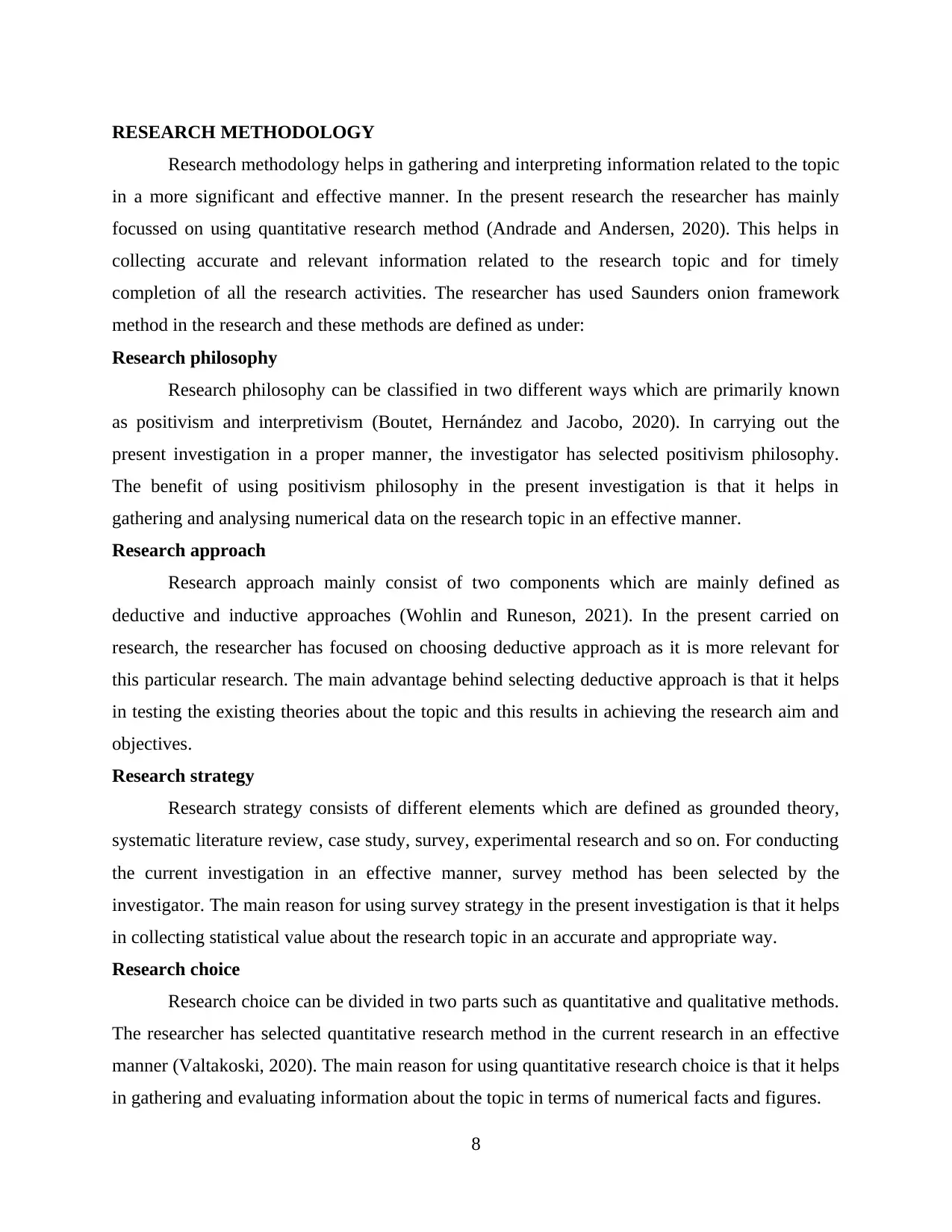
RESEARCH METHODOLOGY
Research methodology helps in gathering and interpreting information related to the topic
in a more significant and effective manner. In the present research the researcher has mainly
focussed on using quantitative research method (Andrade and Andersen, 2020). This helps in
collecting accurate and relevant information related to the research topic and for timely
completion of all the research activities. The researcher has used Saunders onion framework
method in the research and these methods are defined as under:
Research philosophy
Research philosophy can be classified in two different ways which are primarily known
as positivism and interpretivism (Boutet, Hernández and Jacobo, 2020). In carrying out the
present investigation in a proper manner, the investigator has selected positivism philosophy.
The benefit of using positivism philosophy in the present investigation is that it helps in
gathering and analysing numerical data on the research topic in an effective manner.
Research approach
Research approach mainly consist of two components which are mainly defined as
deductive and inductive approaches (Wohlin and Runeson, 2021). In the present carried on
research, the researcher has focused on choosing deductive approach as it is more relevant for
this particular research. The main advantage behind selecting deductive approach is that it helps
in testing the existing theories about the topic and this results in achieving the research aim and
objectives.
Research strategy
Research strategy consists of different elements which are defined as grounded theory,
systematic literature review, case study, survey, experimental research and so on. For conducting
the current investigation in an effective manner, survey method has been selected by the
investigator. The main reason for using survey strategy in the present investigation is that it helps
in collecting statistical value about the research topic in an accurate and appropriate way.
Research choice
Research choice can be divided in two parts such as quantitative and qualitative methods.
The researcher has selected quantitative research method in the current research in an effective
manner (Valtakoski, 2020). The main reason for using quantitative research choice is that it helps
in gathering and evaluating information about the topic in terms of numerical facts and figures.
8
Research methodology helps in gathering and interpreting information related to the topic
in a more significant and effective manner. In the present research the researcher has mainly
focussed on using quantitative research method (Andrade and Andersen, 2020). This helps in
collecting accurate and relevant information related to the research topic and for timely
completion of all the research activities. The researcher has used Saunders onion framework
method in the research and these methods are defined as under:
Research philosophy
Research philosophy can be classified in two different ways which are primarily known
as positivism and interpretivism (Boutet, Hernández and Jacobo, 2020). In carrying out the
present investigation in a proper manner, the investigator has selected positivism philosophy.
The benefit of using positivism philosophy in the present investigation is that it helps in
gathering and analysing numerical data on the research topic in an effective manner.
Research approach
Research approach mainly consist of two components which are mainly defined as
deductive and inductive approaches (Wohlin and Runeson, 2021). In the present carried on
research, the researcher has focused on choosing deductive approach as it is more relevant for
this particular research. The main advantage behind selecting deductive approach is that it helps
in testing the existing theories about the topic and this results in achieving the research aim and
objectives.
Research strategy
Research strategy consists of different elements which are defined as grounded theory,
systematic literature review, case study, survey, experimental research and so on. For conducting
the current investigation in an effective manner, survey method has been selected by the
investigator. The main reason for using survey strategy in the present investigation is that it helps
in collecting statistical value about the research topic in an accurate and appropriate way.
Research choice
Research choice can be divided in two parts such as quantitative and qualitative methods.
The researcher has selected quantitative research method in the current research in an effective
manner (Valtakoski, 2020). The main reason for using quantitative research choice is that it helps
in gathering and evaluating information about the topic in terms of numerical facts and figures.
8
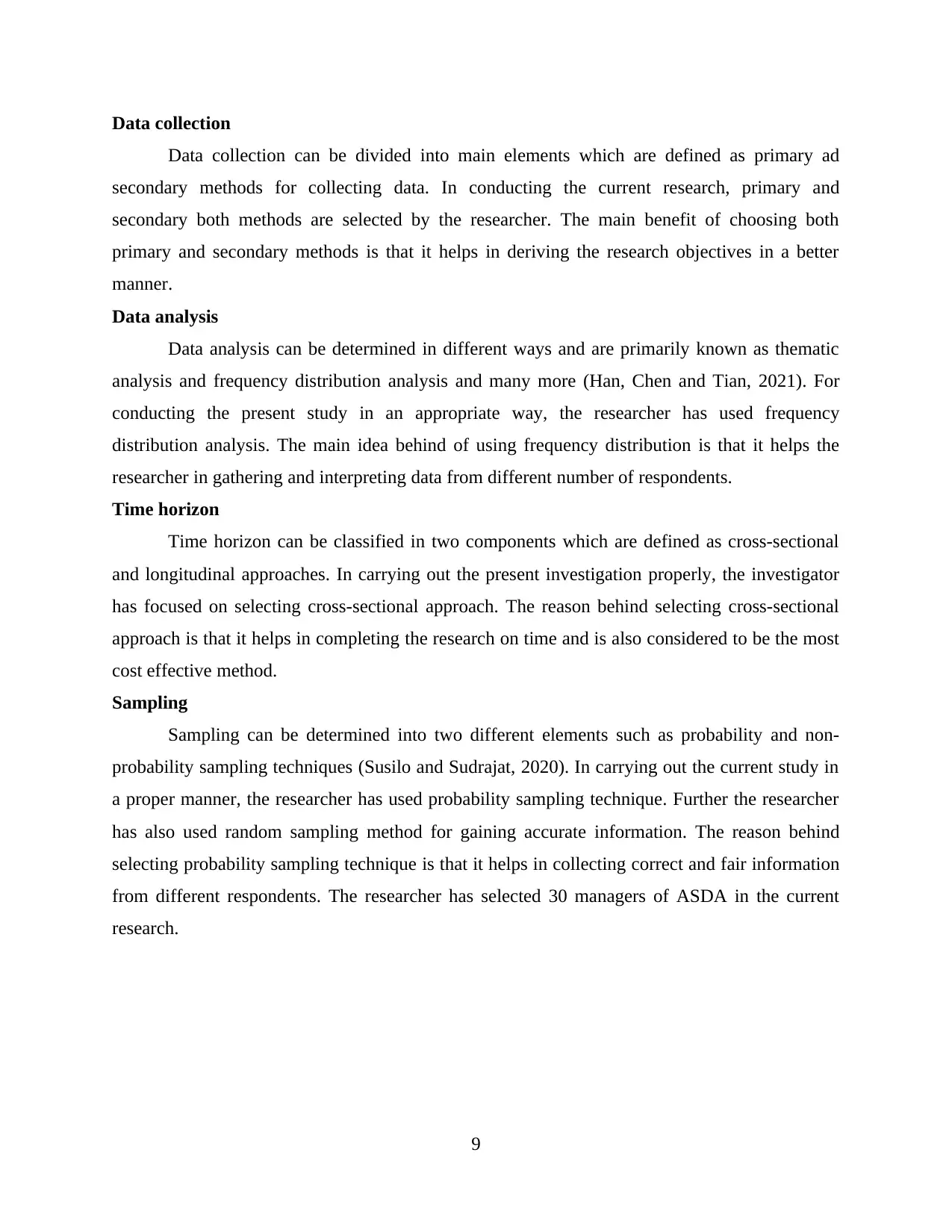
Data collection
Data collection can be divided into main elements which are defined as primary ad
secondary methods for collecting data. In conducting the current research, primary and
secondary both methods are selected by the researcher. The main benefit of choosing both
primary and secondary methods is that it helps in deriving the research objectives in a better
manner.
Data analysis
Data analysis can be determined in different ways and are primarily known as thematic
analysis and frequency distribution analysis and many more (Han, Chen and Tian, 2021). For
conducting the present study in an appropriate way, the researcher has used frequency
distribution analysis. The main idea behind of using frequency distribution is that it helps the
researcher in gathering and interpreting data from different number of respondents.
Time horizon
Time horizon can be classified in two components which are defined as cross-sectional
and longitudinal approaches. In carrying out the present investigation properly, the investigator
has focused on selecting cross-sectional approach. The reason behind selecting cross-sectional
approach is that it helps in completing the research on time and is also considered to be the most
cost effective method.
Sampling
Sampling can be determined into two different elements such as probability and non-
probability sampling techniques (Susilo and Sudrajat, 2020). In carrying out the current study in
a proper manner, the researcher has used probability sampling technique. Further the researcher
has also used random sampling method for gaining accurate information. The reason behind
selecting probability sampling technique is that it helps in collecting correct and fair information
from different respondents. The researcher has selected 30 managers of ASDA in the current
research.
9
Data collection can be divided into main elements which are defined as primary ad
secondary methods for collecting data. In conducting the current research, primary and
secondary both methods are selected by the researcher. The main benefit of choosing both
primary and secondary methods is that it helps in deriving the research objectives in a better
manner.
Data analysis
Data analysis can be determined in different ways and are primarily known as thematic
analysis and frequency distribution analysis and many more (Han, Chen and Tian, 2021). For
conducting the present study in an appropriate way, the researcher has used frequency
distribution analysis. The main idea behind of using frequency distribution is that it helps the
researcher in gathering and interpreting data from different number of respondents.
Time horizon
Time horizon can be classified in two components which are defined as cross-sectional
and longitudinal approaches. In carrying out the present investigation properly, the investigator
has focused on selecting cross-sectional approach. The reason behind selecting cross-sectional
approach is that it helps in completing the research on time and is also considered to be the most
cost effective method.
Sampling
Sampling can be determined into two different elements such as probability and non-
probability sampling techniques (Susilo and Sudrajat, 2020). In carrying out the current study in
a proper manner, the researcher has used probability sampling technique. Further the researcher
has also used random sampling method for gaining accurate information. The reason behind
selecting probability sampling technique is that it helps in collecting correct and fair information
from different respondents. The researcher has selected 30 managers of ASDA in the current
research.
9
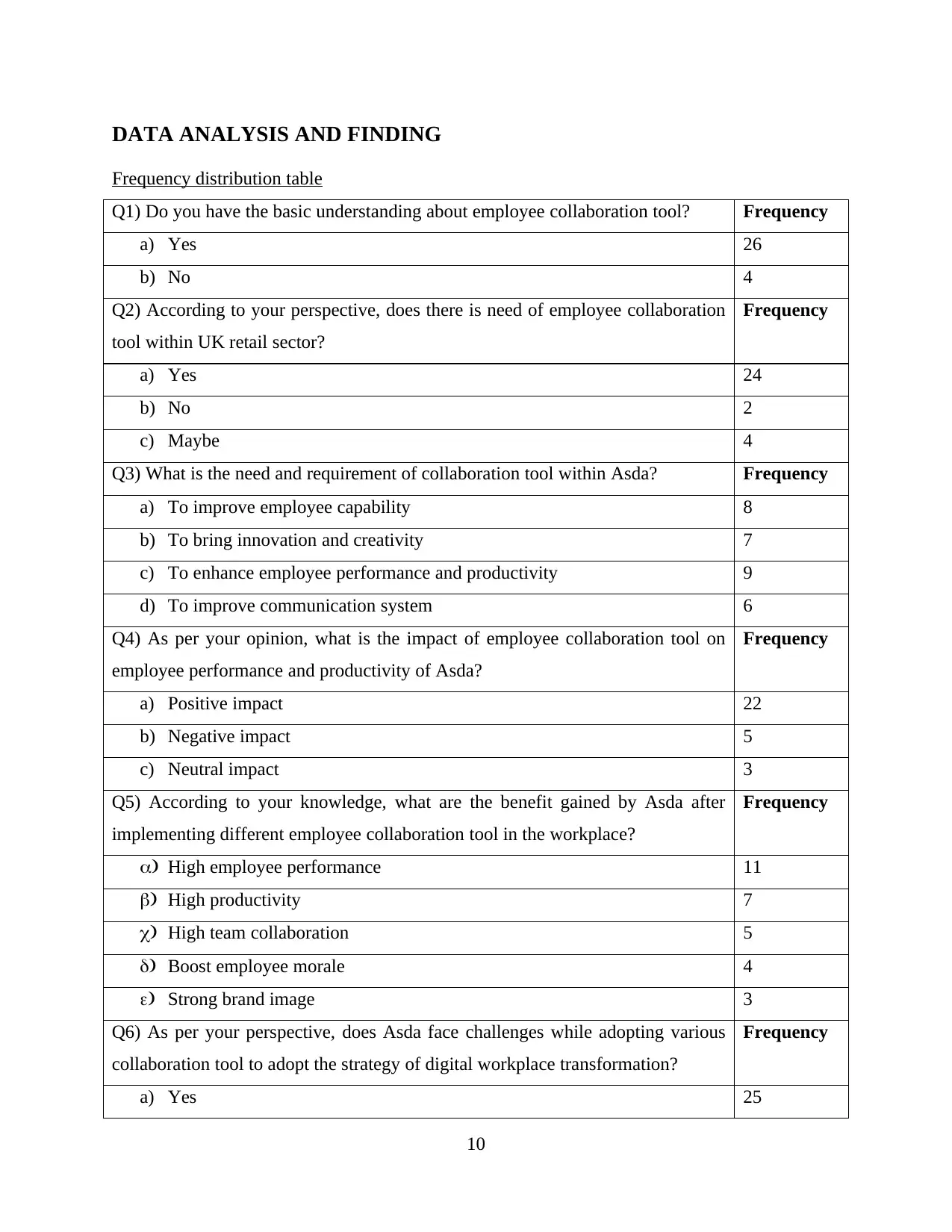
DATA ANALYSIS AND FINDING
Frequency distribution table
Q1) Do you have the basic understanding about employee collaboration tool? Frequency
a) Yes 26
b) No 4
Q2) According to your perspective, does there is need of employee collaboration
tool within UK retail sector?
Frequency
a) Yes 24
b) No 2
c) Maybe 4
Q3) What is the need and requirement of collaboration tool within Asda? Frequency
a) To improve employee capability 8
b) To bring innovation and creativity 7
c) To enhance employee performance and productivity 9
d) To improve communication system 6
Q4) As per your opinion, what is the impact of employee collaboration tool on
employee performance and productivity of Asda?
Frequency
a) Positive impact 22
b) Negative impact 5
c) Neutral impact 3
Q5) According to your knowledge, what are the benefit gained by Asda after
implementing different employee collaboration tool in the workplace?
Frequency
a) High employee performance 11
b) High productivity 7
c) High team collaboration 5
d) Boost employee morale 4
e) Strong brand image 3
Q6) As per your perspective, does Asda face challenges while adopting various
collaboration tool to adopt the strategy of digital workplace transformation?
Frequency
a) Yes 25
10
Frequency distribution table
Q1) Do you have the basic understanding about employee collaboration tool? Frequency
a) Yes 26
b) No 4
Q2) According to your perspective, does there is need of employee collaboration
tool within UK retail sector?
Frequency
a) Yes 24
b) No 2
c) Maybe 4
Q3) What is the need and requirement of collaboration tool within Asda? Frequency
a) To improve employee capability 8
b) To bring innovation and creativity 7
c) To enhance employee performance and productivity 9
d) To improve communication system 6
Q4) As per your opinion, what is the impact of employee collaboration tool on
employee performance and productivity of Asda?
Frequency
a) Positive impact 22
b) Negative impact 5
c) Neutral impact 3
Q5) According to your knowledge, what are the benefit gained by Asda after
implementing different employee collaboration tool in the workplace?
Frequency
a) High employee performance 11
b) High productivity 7
c) High team collaboration 5
d) Boost employee morale 4
e) Strong brand image 3
Q6) As per your perspective, does Asda face challenges while adopting various
collaboration tool to adopt the strategy of digital workplace transformation?
Frequency
a) Yes 25
10
Secure Best Marks with AI Grader
Need help grading? Try our AI Grader for instant feedback on your assignments.
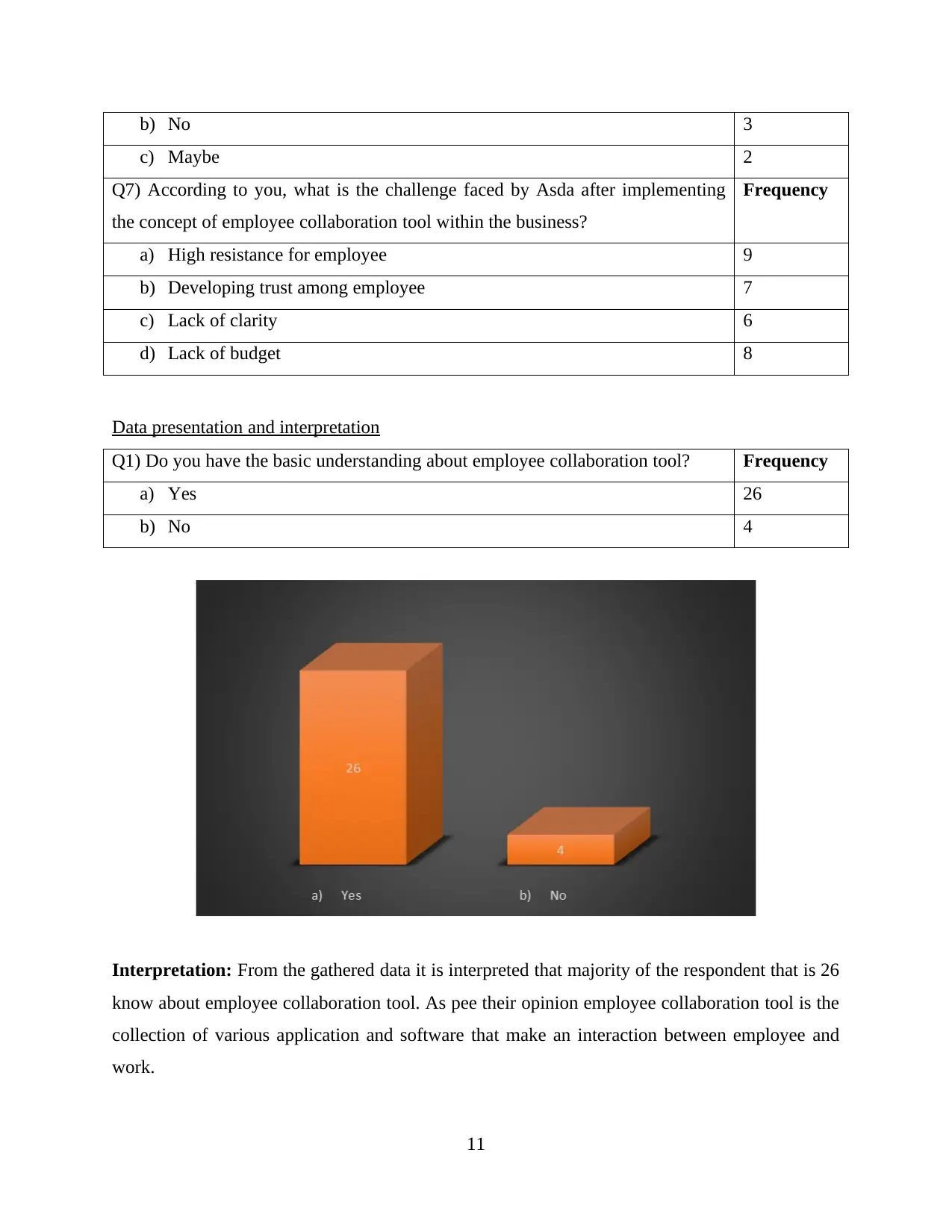
b) No 3
c) Maybe 2
Q7) According to you, what is the challenge faced by Asda after implementing
the concept of employee collaboration tool within the business?
Frequency
a) High resistance for employee 9
b) Developing trust among employee 7
c) Lack of clarity 6
d) Lack of budget 8
Data presentation and interpretation
Q1) Do you have the basic understanding about employee collaboration tool? Frequency
a) Yes 26
b) No 4
Interpretation: From the gathered data it is interpreted that majority of the respondent that is 26
know about employee collaboration tool. As pee their opinion employee collaboration tool is the
collection of various application and software that make an interaction between employee and
work.
11
c) Maybe 2
Q7) According to you, what is the challenge faced by Asda after implementing
the concept of employee collaboration tool within the business?
Frequency
a) High resistance for employee 9
b) Developing trust among employee 7
c) Lack of clarity 6
d) Lack of budget 8
Data presentation and interpretation
Q1) Do you have the basic understanding about employee collaboration tool? Frequency
a) Yes 26
b) No 4
Interpretation: From the gathered data it is interpreted that majority of the respondent that is 26
know about employee collaboration tool. As pee their opinion employee collaboration tool is the
collection of various application and software that make an interaction between employee and
work.
11
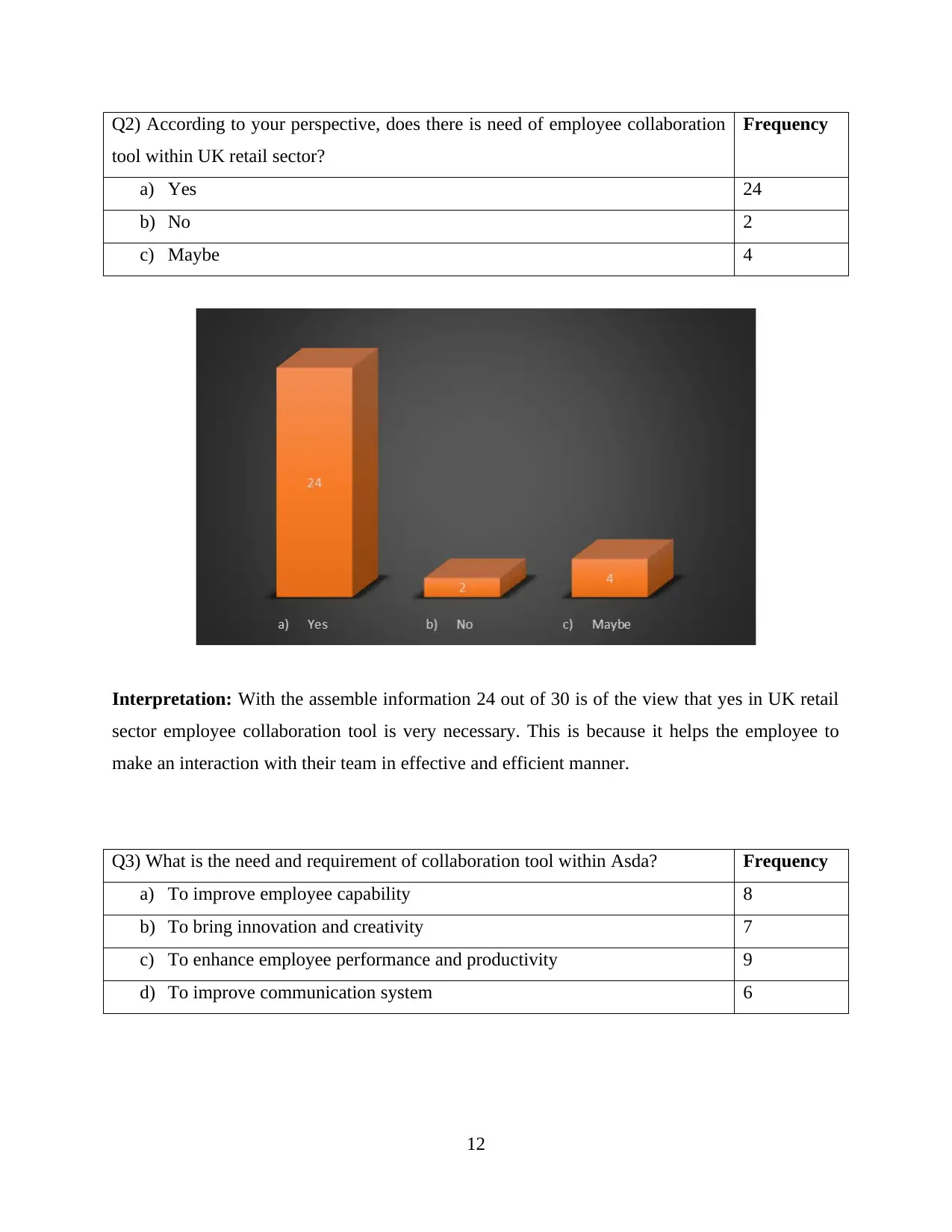
Q2) According to your perspective, does there is need of employee collaboration
tool within UK retail sector?
Frequency
a) Yes 24
b) No 2
c) Maybe 4
Interpretation: With the assemble information 24 out of 30 is of the view that yes in UK retail
sector employee collaboration tool is very necessary. This is because it helps the employee to
make an interaction with their team in effective and efficient manner.
Q3) What is the need and requirement of collaboration tool within Asda? Frequency
a) To improve employee capability 8
b) To bring innovation and creativity 7
c) To enhance employee performance and productivity 9
d) To improve communication system 6
12
tool within UK retail sector?
Frequency
a) Yes 24
b) No 2
c) Maybe 4
Interpretation: With the assemble information 24 out of 30 is of the view that yes in UK retail
sector employee collaboration tool is very necessary. This is because it helps the employee to
make an interaction with their team in effective and efficient manner.
Q3) What is the need and requirement of collaboration tool within Asda? Frequency
a) To improve employee capability 8
b) To bring innovation and creativity 7
c) To enhance employee performance and productivity 9
d) To improve communication system 6
12
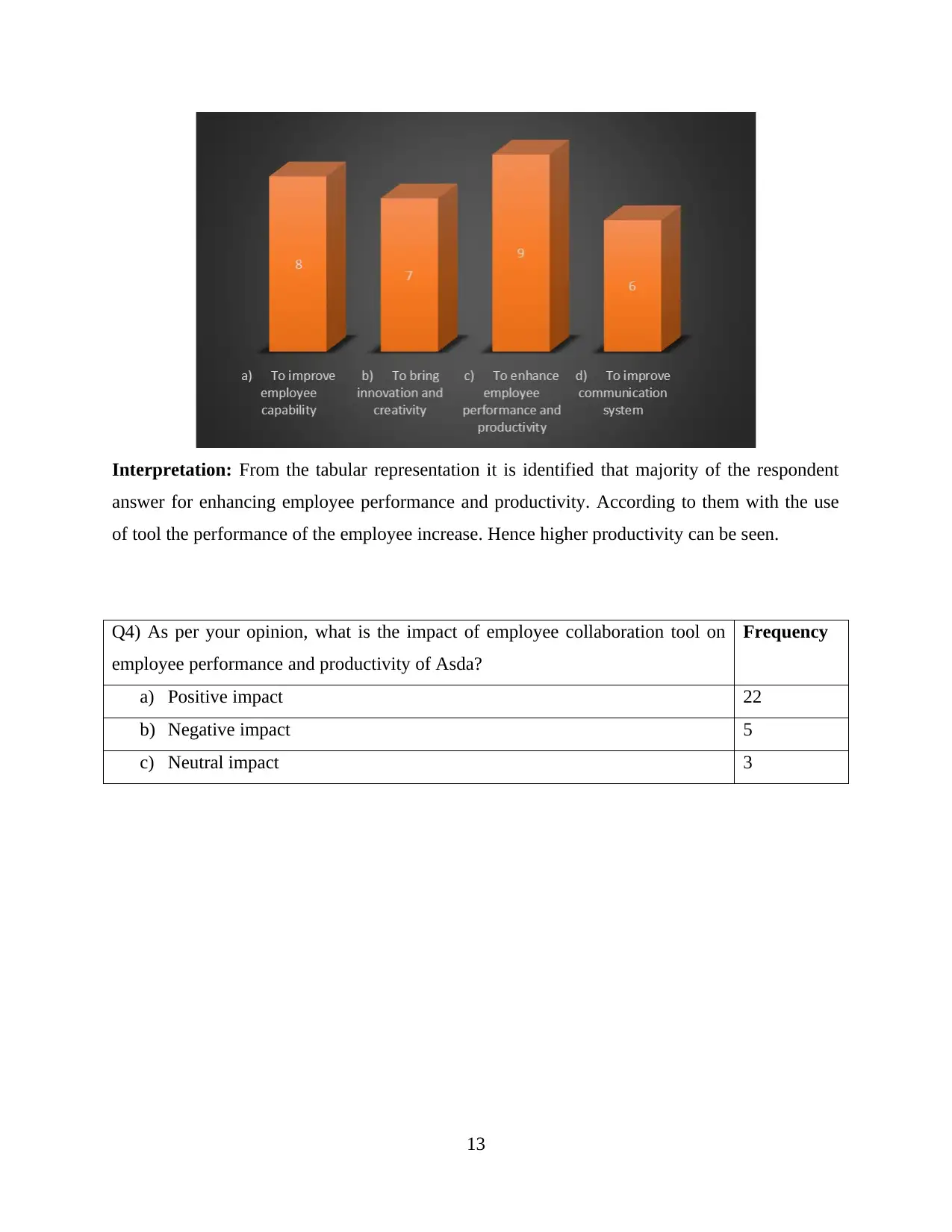
Interpretation: From the tabular representation it is identified that majority of the respondent
answer for enhancing employee performance and productivity. According to them with the use
of tool the performance of the employee increase. Hence higher productivity can be seen.
Q4) As per your opinion, what is the impact of employee collaboration tool on
employee performance and productivity of Asda?
Frequency
a) Positive impact 22
b) Negative impact 5
c) Neutral impact 3
13
answer for enhancing employee performance and productivity. According to them with the use
of tool the performance of the employee increase. Hence higher productivity can be seen.
Q4) As per your opinion, what is the impact of employee collaboration tool on
employee performance and productivity of Asda?
Frequency
a) Positive impact 22
b) Negative impact 5
c) Neutral impact 3
13
Paraphrase This Document
Need a fresh take? Get an instant paraphrase of this document with our AI Paraphraser
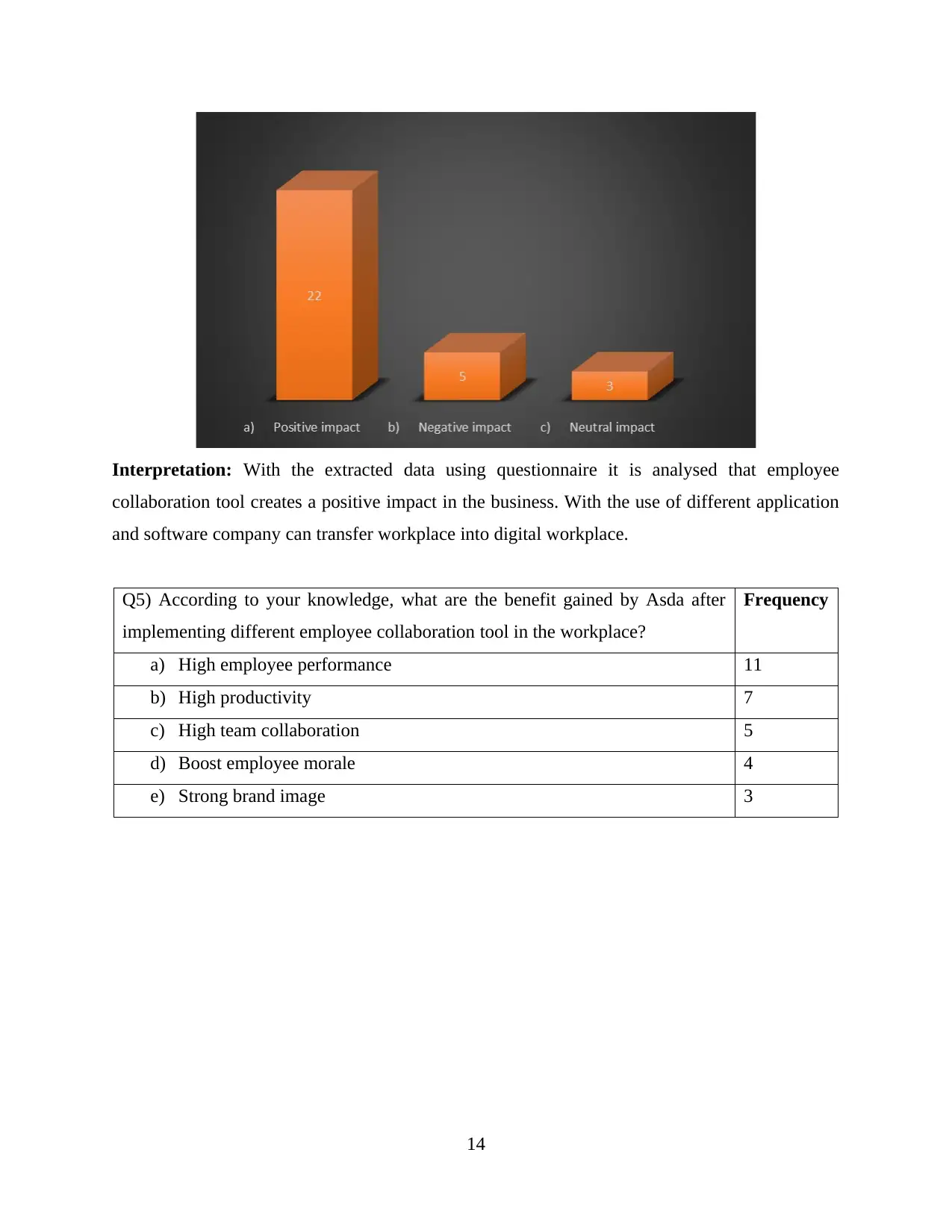
Interpretation: With the extracted data using questionnaire it is analysed that employee
collaboration tool creates a positive impact in the business. With the use of different application
and software company can transfer workplace into digital workplace.
Q5) According to your knowledge, what are the benefit gained by Asda after
implementing different employee collaboration tool in the workplace?
Frequency
a) High employee performance 11
b) High productivity 7
c) High team collaboration 5
d) Boost employee morale 4
e) Strong brand image 3
14
collaboration tool creates a positive impact in the business. With the use of different application
and software company can transfer workplace into digital workplace.
Q5) According to your knowledge, what are the benefit gained by Asda after
implementing different employee collaboration tool in the workplace?
Frequency
a) High employee performance 11
b) High productivity 7
c) High team collaboration 5
d) Boost employee morale 4
e) Strong brand image 3
14
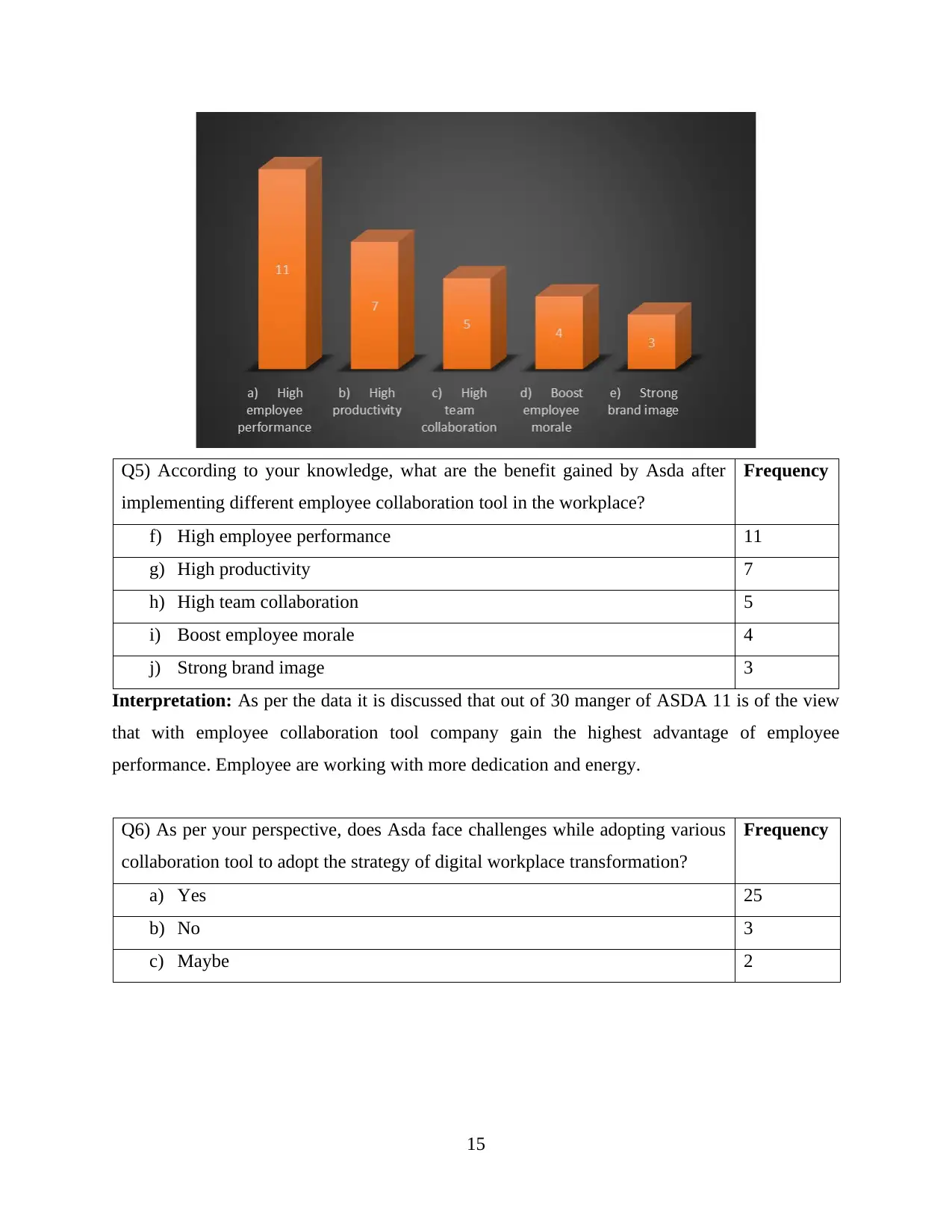
Q5) According to your knowledge, what are the benefit gained by Asda after
implementing different employee collaboration tool in the workplace?
Frequency
f) High employee performance 11
g) High productivity 7
h) High team collaboration 5
i) Boost employee morale 4
j) Strong brand image 3
Interpretation: As per the data it is discussed that out of 30 manger of ASDA 11 is of the view
that with employee collaboration tool company gain the highest advantage of employee
performance. Employee are working with more dedication and energy.
Q6) As per your perspective, does Asda face challenges while adopting various
collaboration tool to adopt the strategy of digital workplace transformation?
Frequency
a) Yes 25
b) No 3
c) Maybe 2
15
implementing different employee collaboration tool in the workplace?
Frequency
f) High employee performance 11
g) High productivity 7
h) High team collaboration 5
i) Boost employee morale 4
j) Strong brand image 3
Interpretation: As per the data it is discussed that out of 30 manger of ASDA 11 is of the view
that with employee collaboration tool company gain the highest advantage of employee
performance. Employee are working with more dedication and energy.
Q6) As per your perspective, does Asda face challenges while adopting various
collaboration tool to adopt the strategy of digital workplace transformation?
Frequency
a) Yes 25
b) No 3
c) Maybe 2
15
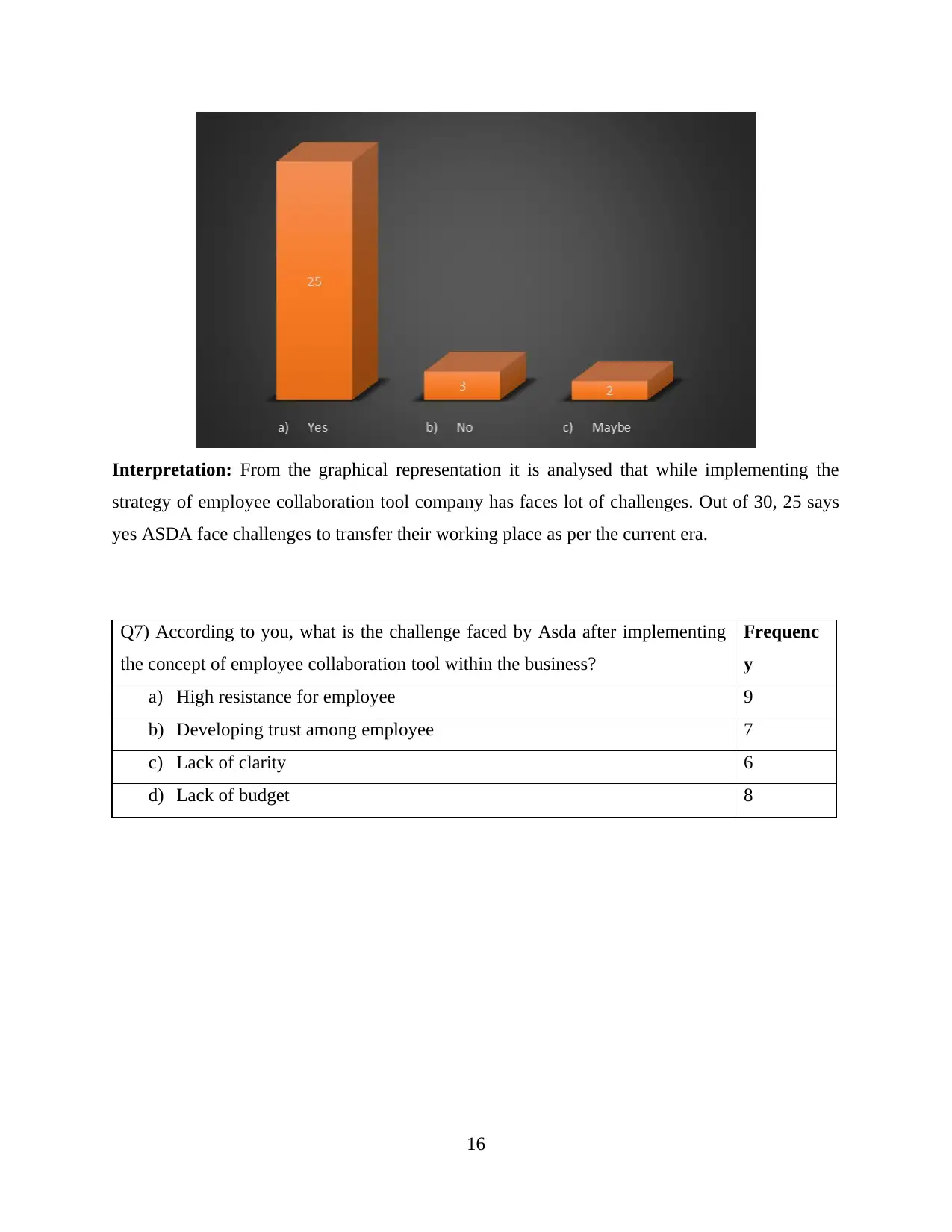
Interpretation: From the graphical representation it is analysed that while implementing the
strategy of employee collaboration tool company has faces lot of challenges. Out of 30, 25 says
yes ASDA face challenges to transfer their working place as per the current era.
Q7) According to you, what is the challenge faced by Asda after implementing
the concept of employee collaboration tool within the business?
Frequenc
y
a) High resistance for employee 9
b) Developing trust among employee 7
c) Lack of clarity 6
d) Lack of budget 8
16
strategy of employee collaboration tool company has faces lot of challenges. Out of 30, 25 says
yes ASDA face challenges to transfer their working place as per the current era.
Q7) According to you, what is the challenge faced by Asda after implementing
the concept of employee collaboration tool within the business?
Frequenc
y
a) High resistance for employee 9
b) Developing trust among employee 7
c) Lack of clarity 6
d) Lack of budget 8
16
Secure Best Marks with AI Grader
Need help grading? Try our AI Grader for instant feedback on your assignments.
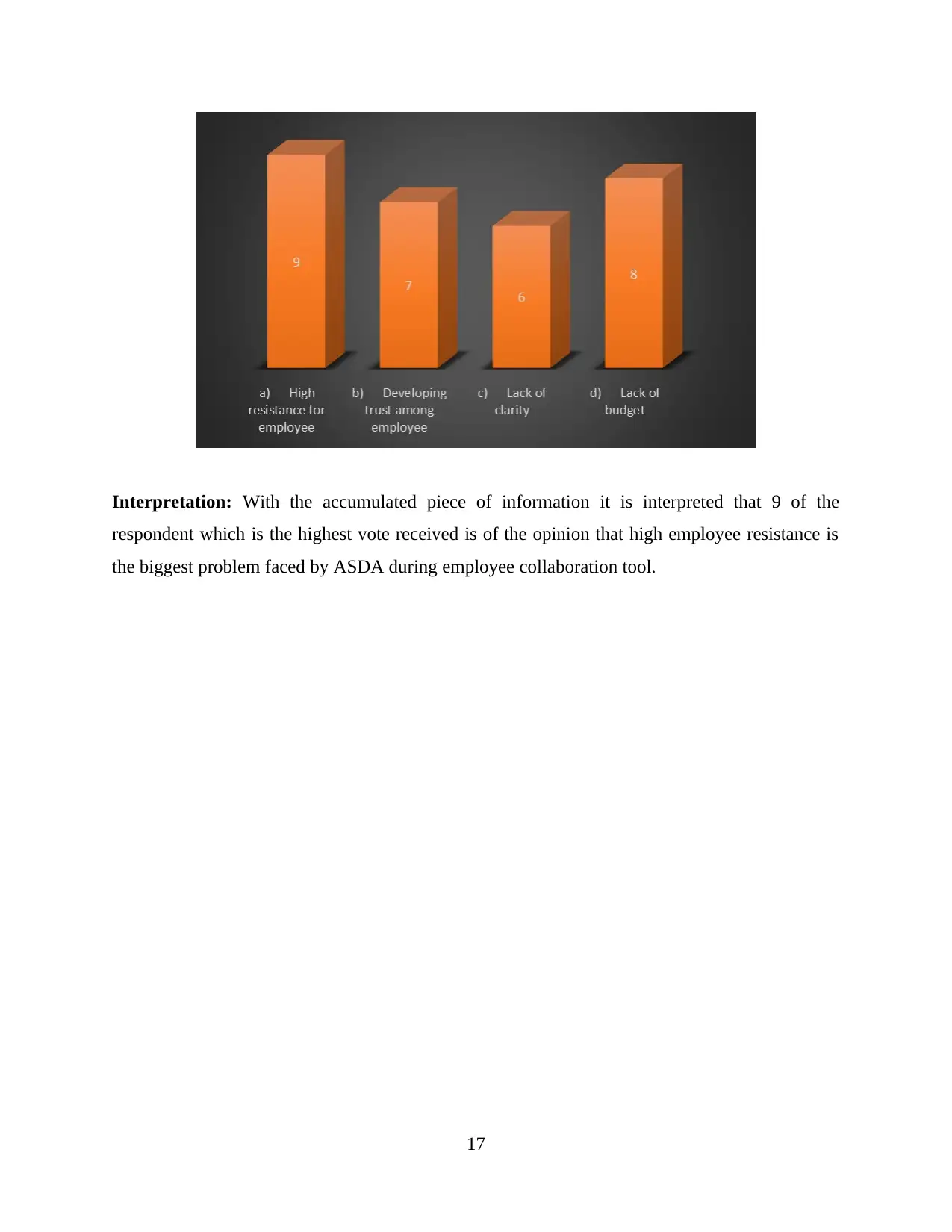
Interpretation: With the accumulated piece of information it is interpreted that 9 of the
respondent which is the highest vote received is of the opinion that high employee resistance is
the biggest problem faced by ASDA during employee collaboration tool.
17
respondent which is the highest vote received is of the opinion that high employee resistance is
the biggest problem faced by ASDA during employee collaboration tool.
17
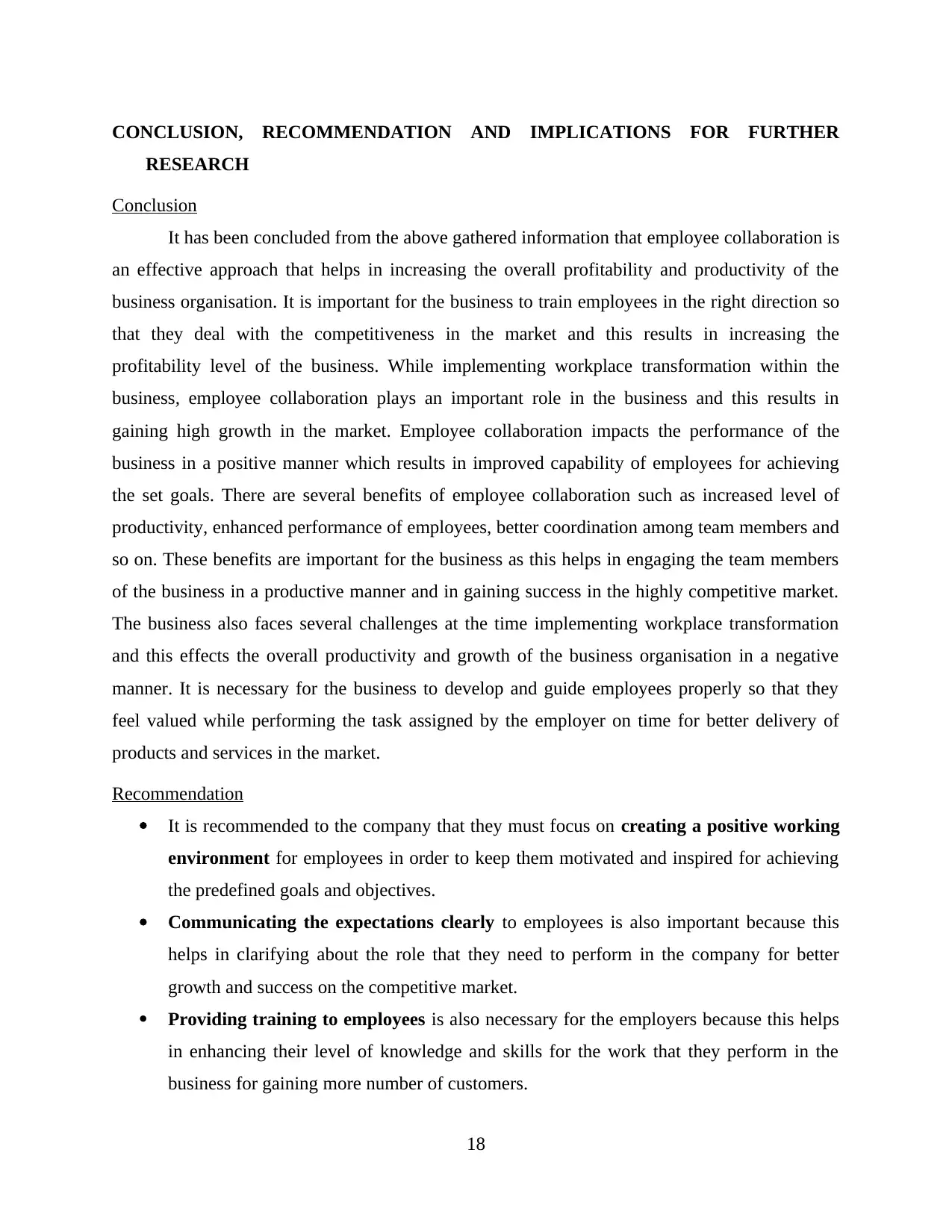
CONCLUSION, RECOMMENDATION AND IMPLICATIONS FOR FURTHER
RESEARCH
Conclusion
It has been concluded from the above gathered information that employee collaboration is
an effective approach that helps in increasing the overall profitability and productivity of the
business organisation. It is important for the business to train employees in the right direction so
that they deal with the competitiveness in the market and this results in increasing the
profitability level of the business. While implementing workplace transformation within the
business, employee collaboration plays an important role in the business and this results in
gaining high growth in the market. Employee collaboration impacts the performance of the
business in a positive manner which results in improved capability of employees for achieving
the set goals. There are several benefits of employee collaboration such as increased level of
productivity, enhanced performance of employees, better coordination among team members and
so on. These benefits are important for the business as this helps in engaging the team members
of the business in a productive manner and in gaining success in the highly competitive market.
The business also faces several challenges at the time implementing workplace transformation
and this effects the overall productivity and growth of the business organisation in a negative
manner. It is necessary for the business to develop and guide employees properly so that they
feel valued while performing the task assigned by the employer on time for better delivery of
products and services in the market.
Recommendation
It is recommended to the company that they must focus on creating a positive working
environment for employees in order to keep them motivated and inspired for achieving
the predefined goals and objectives.
Communicating the expectations clearly to employees is also important because this
helps in clarifying about the role that they need to perform in the company for better
growth and success on the competitive market.
Providing training to employees is also necessary for the employers because this helps
in enhancing their level of knowledge and skills for the work that they perform in the
business for gaining more number of customers.
18
RESEARCH
Conclusion
It has been concluded from the above gathered information that employee collaboration is
an effective approach that helps in increasing the overall profitability and productivity of the
business organisation. It is important for the business to train employees in the right direction so
that they deal with the competitiveness in the market and this results in increasing the
profitability level of the business. While implementing workplace transformation within the
business, employee collaboration plays an important role in the business and this results in
gaining high growth in the market. Employee collaboration impacts the performance of the
business in a positive manner which results in improved capability of employees for achieving
the set goals. There are several benefits of employee collaboration such as increased level of
productivity, enhanced performance of employees, better coordination among team members and
so on. These benefits are important for the business as this helps in engaging the team members
of the business in a productive manner and in gaining success in the highly competitive market.
The business also faces several challenges at the time implementing workplace transformation
and this effects the overall productivity and growth of the business organisation in a negative
manner. It is necessary for the business to develop and guide employees properly so that they
feel valued while performing the task assigned by the employer on time for better delivery of
products and services in the market.
Recommendation
It is recommended to the company that they must focus on creating a positive working
environment for employees in order to keep them motivated and inspired for achieving
the predefined goals and objectives.
Communicating the expectations clearly to employees is also important because this
helps in clarifying about the role that they need to perform in the company for better
growth and success on the competitive market.
Providing training to employees is also necessary for the employers because this helps
in enhancing their level of knowledge and skills for the work that they perform in the
business for gaining more number of customers.
18

Implications for further research
The present research would help future researchers in gathering and analysing more
insight data about the topic and this results in addressing the research aim and objectives in a
more productive manner. This also helps the researchers in fulfilling the gap of the research so
that they complete the research without any problem.
19
The present research would help future researchers in gathering and analysing more
insight data about the topic and this results in addressing the research aim and objectives in a
more productive manner. This also helps the researchers in fulfilling the gap of the research so
that they complete the research without any problem.
19
Paraphrase This Document
Need a fresh take? Get an instant paraphrase of this document with our AI Paraphraser
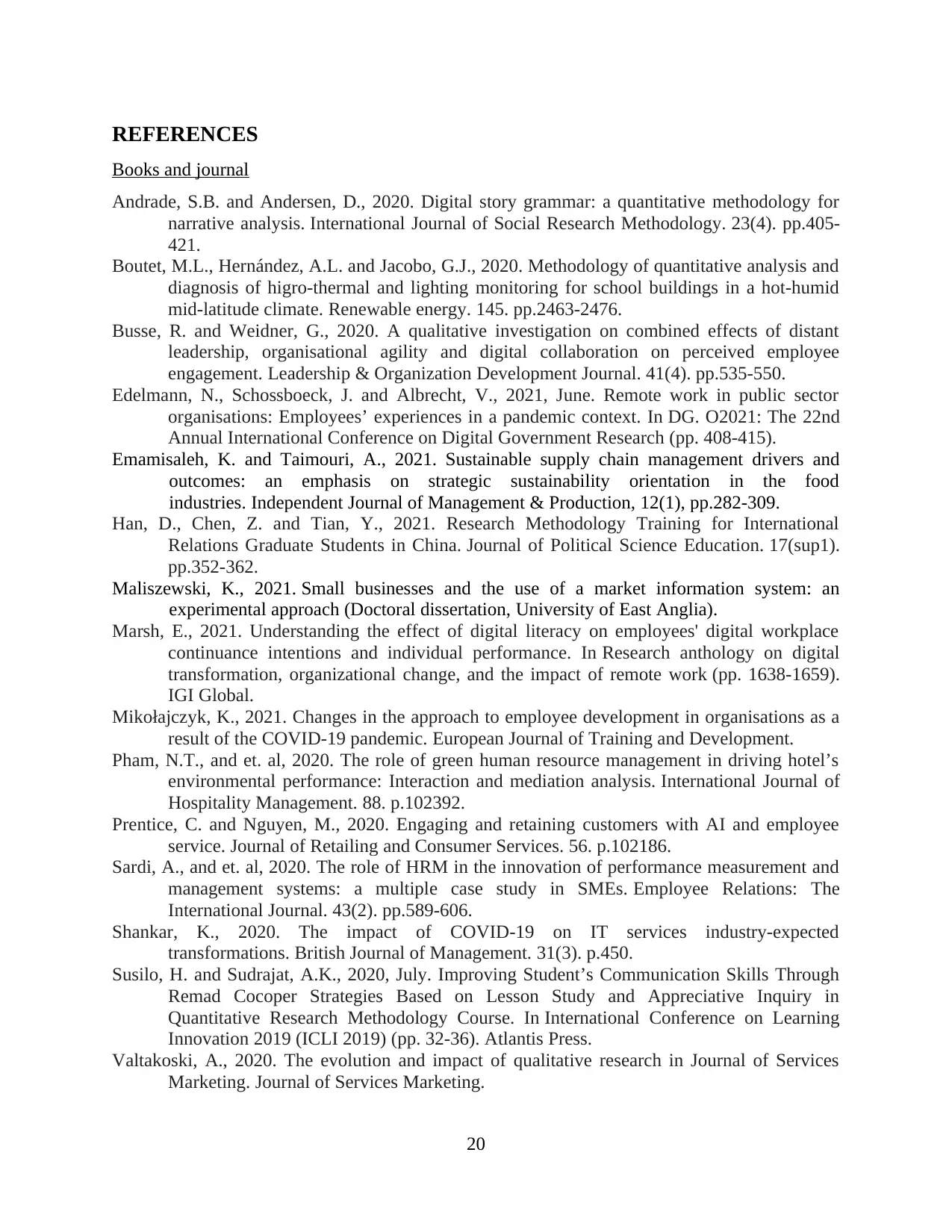
REFERENCES
Books and journal
Andrade, S.B. and Andersen, D., 2020. Digital story grammar: a quantitative methodology for
narrative analysis. International Journal of Social Research Methodology. 23(4). pp.405-
421.
Boutet, M.L., Hernández, A.L. and Jacobo, G.J., 2020. Methodology of quantitative analysis and
diagnosis of higro-thermal and lighting monitoring for school buildings in a hot-humid
mid-latitude climate. Renewable energy. 145. pp.2463-2476.
Busse, R. and Weidner, G., 2020. A qualitative investigation on combined effects of distant
leadership, organisational agility and digital collaboration on perceived employee
engagement. Leadership & Organization Development Journal. 41(4). pp.535-550.
Edelmann, N., Schossboeck, J. and Albrecht, V., 2021, June. Remote work in public sector
organisations: Employees’ experiences in a pandemic context. In DG. O2021: The 22nd
Annual International Conference on Digital Government Research (pp. 408-415).
Emamisaleh, K. and Taimouri, A., 2021. Sustainable supply chain management drivers and
outcomes: an emphasis on strategic sustainability orientation in the food
industries. Independent Journal of Management & Production, 12(1), pp.282-309.
Han, D., Chen, Z. and Tian, Y., 2021. Research Methodology Training for International
Relations Graduate Students in China. Journal of Political Science Education. 17(sup1).
pp.352-362.
Maliszewski, K., 2021. Small businesses and the use of a market information system: an
experimental approach (Doctoral dissertation, University of East Anglia).
Marsh, E., 2021. Understanding the effect of digital literacy on employees' digital workplace
continuance intentions and individual performance. In Research anthology on digital
transformation, organizational change, and the impact of remote work (pp. 1638-1659).
IGI Global.
Mikołajczyk, K., 2021. Changes in the approach to employee development in organisations as a
result of the COVID-19 pandemic. European Journal of Training and Development.
Pham, N.T., and et. al, 2020. The role of green human resource management in driving hotel’s
environmental performance: Interaction and mediation analysis. International Journal of
Hospitality Management. 88. p.102392.
Prentice, C. and Nguyen, M., 2020. Engaging and retaining customers with AI and employee
service. Journal of Retailing and Consumer Services. 56. p.102186.
Sardi, A., and et. al, 2020. The role of HRM in the innovation of performance measurement and
management systems: a multiple case study in SMEs. Employee Relations: The
International Journal. 43(2). pp.589-606.
Shankar, K., 2020. The impact of COVID‐19 on IT services industry‐expected
transformations. British Journal of Management. 31(3). p.450.
Susilo, H. and Sudrajat, A.K., 2020, July. Improving Student’s Communication Skills Through
Remad Cocoper Strategies Based on Lesson Study and Appreciative Inquiry in
Quantitative Research Methodology Course. In International Conference on Learning
Innovation 2019 (ICLI 2019) (pp. 32-36). Atlantis Press.
Valtakoski, A., 2020. The evolution and impact of qualitative research in Journal of Services
Marketing. Journal of Services Marketing.
20
Books and journal
Andrade, S.B. and Andersen, D., 2020. Digital story grammar: a quantitative methodology for
narrative analysis. International Journal of Social Research Methodology. 23(4). pp.405-
421.
Boutet, M.L., Hernández, A.L. and Jacobo, G.J., 2020. Methodology of quantitative analysis and
diagnosis of higro-thermal and lighting monitoring for school buildings in a hot-humid
mid-latitude climate. Renewable energy. 145. pp.2463-2476.
Busse, R. and Weidner, G., 2020. A qualitative investigation on combined effects of distant
leadership, organisational agility and digital collaboration on perceived employee
engagement. Leadership & Organization Development Journal. 41(4). pp.535-550.
Edelmann, N., Schossboeck, J. and Albrecht, V., 2021, June. Remote work in public sector
organisations: Employees’ experiences in a pandemic context. In DG. O2021: The 22nd
Annual International Conference on Digital Government Research (pp. 408-415).
Emamisaleh, K. and Taimouri, A., 2021. Sustainable supply chain management drivers and
outcomes: an emphasis on strategic sustainability orientation in the food
industries. Independent Journal of Management & Production, 12(1), pp.282-309.
Han, D., Chen, Z. and Tian, Y., 2021. Research Methodology Training for International
Relations Graduate Students in China. Journal of Political Science Education. 17(sup1).
pp.352-362.
Maliszewski, K., 2021. Small businesses and the use of a market information system: an
experimental approach (Doctoral dissertation, University of East Anglia).
Marsh, E., 2021. Understanding the effect of digital literacy on employees' digital workplace
continuance intentions and individual performance. In Research anthology on digital
transformation, organizational change, and the impact of remote work (pp. 1638-1659).
IGI Global.
Mikołajczyk, K., 2021. Changes in the approach to employee development in organisations as a
result of the COVID-19 pandemic. European Journal of Training and Development.
Pham, N.T., and et. al, 2020. The role of green human resource management in driving hotel’s
environmental performance: Interaction and mediation analysis. International Journal of
Hospitality Management. 88. p.102392.
Prentice, C. and Nguyen, M., 2020. Engaging and retaining customers with AI and employee
service. Journal of Retailing and Consumer Services. 56. p.102186.
Sardi, A., and et. al, 2020. The role of HRM in the innovation of performance measurement and
management systems: a multiple case study in SMEs. Employee Relations: The
International Journal. 43(2). pp.589-606.
Shankar, K., 2020. The impact of COVID‐19 on IT services industry‐expected
transformations. British Journal of Management. 31(3). p.450.
Susilo, H. and Sudrajat, A.K., 2020, July. Improving Student’s Communication Skills Through
Remad Cocoper Strategies Based on Lesson Study and Appreciative Inquiry in
Quantitative Research Methodology Course. In International Conference on Learning
Innovation 2019 (ICLI 2019) (pp. 32-36). Atlantis Press.
Valtakoski, A., 2020. The evolution and impact of qualitative research in Journal of Services
Marketing. Journal of Services Marketing.
20
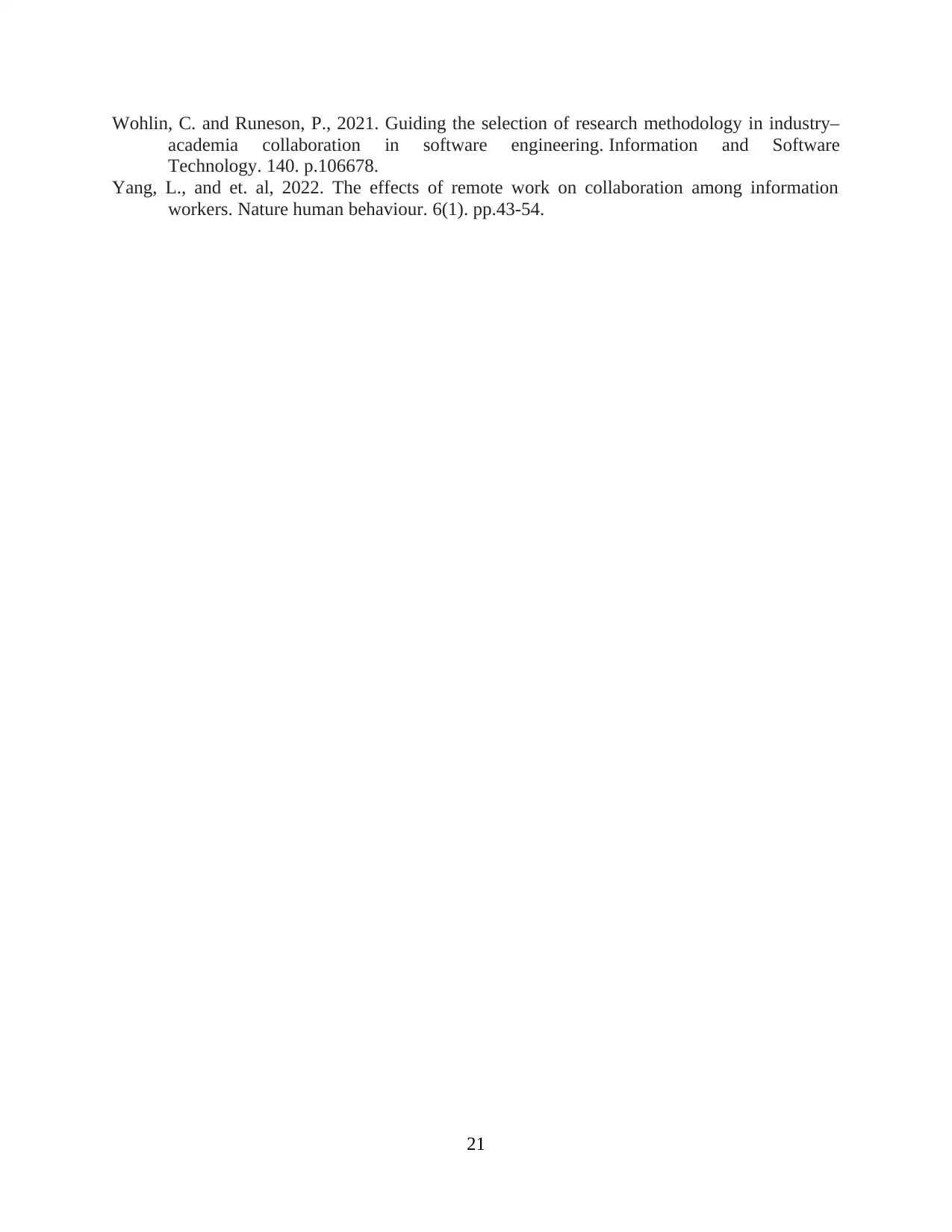
Wohlin, C. and Runeson, P., 2021. Guiding the selection of research methodology in industry–
academia collaboration in software engineering. Information and Software
Technology. 140. p.106678.
Yang, L., and et. al, 2022. The effects of remote work on collaboration among information
workers. Nature human behaviour. 6(1). pp.43-54.
21
academia collaboration in software engineering. Information and Software
Technology. 140. p.106678.
Yang, L., and et. al, 2022. The effects of remote work on collaboration among information
workers. Nature human behaviour. 6(1). pp.43-54.
21
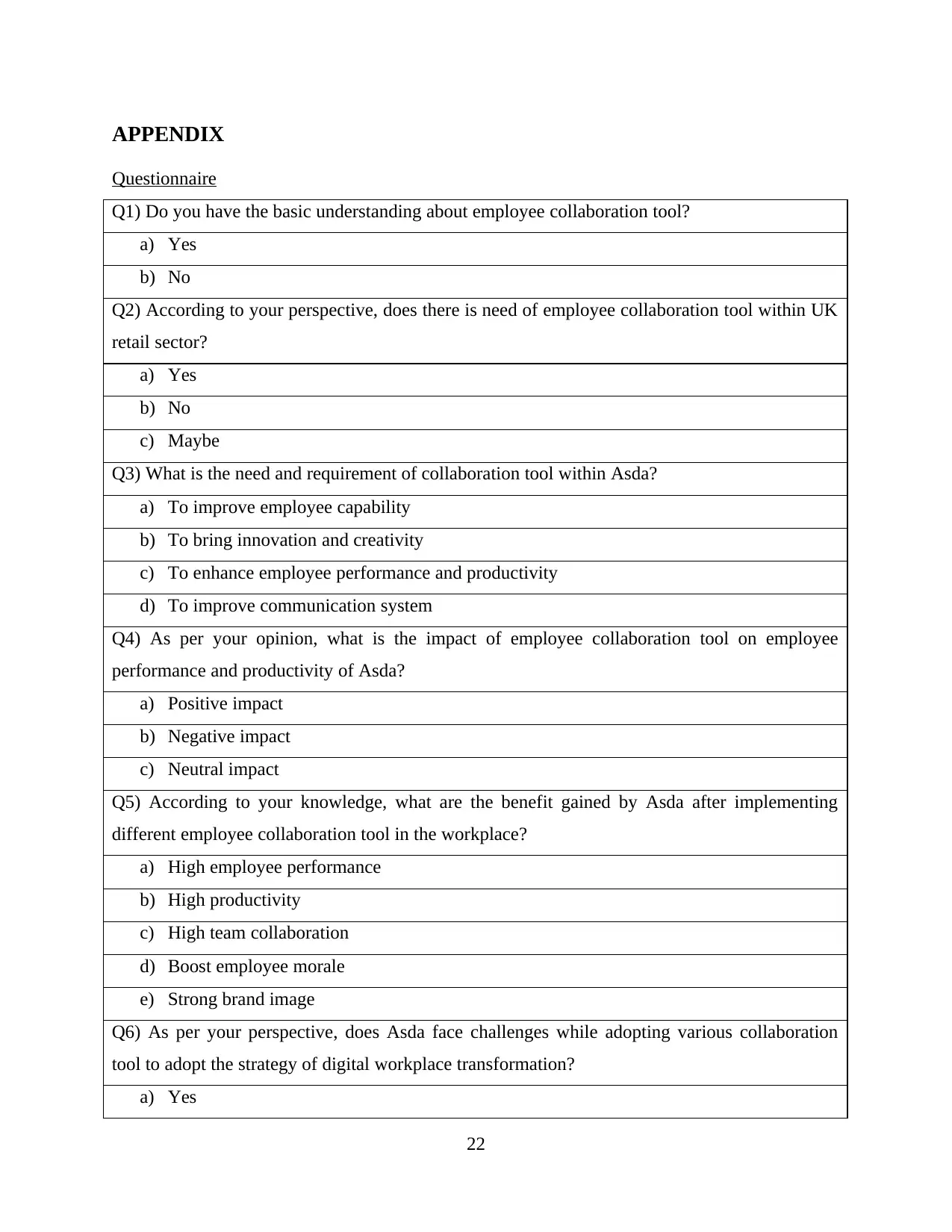
APPENDIX
Questionnaire
Q1) Do you have the basic understanding about employee collaboration tool?
a) Yes
b) No
Q2) According to your perspective, does there is need of employee collaboration tool within UK
retail sector?
a) Yes
b) No
c) Maybe
Q3) What is the need and requirement of collaboration tool within Asda?
a) To improve employee capability
b) To bring innovation and creativity
c) To enhance employee performance and productivity
d) To improve communication system
Q4) As per your opinion, what is the impact of employee collaboration tool on employee
performance and productivity of Asda?
a) Positive impact
b) Negative impact
c) Neutral impact
Q5) According to your knowledge, what are the benefit gained by Asda after implementing
different employee collaboration tool in the workplace?
a) High employee performance
b) High productivity
c) High team collaboration
d) Boost employee morale
e) Strong brand image
Q6) As per your perspective, does Asda face challenges while adopting various collaboration
tool to adopt the strategy of digital workplace transformation?
a) Yes
22
Questionnaire
Q1) Do you have the basic understanding about employee collaboration tool?
a) Yes
b) No
Q2) According to your perspective, does there is need of employee collaboration tool within UK
retail sector?
a) Yes
b) No
c) Maybe
Q3) What is the need and requirement of collaboration tool within Asda?
a) To improve employee capability
b) To bring innovation and creativity
c) To enhance employee performance and productivity
d) To improve communication system
Q4) As per your opinion, what is the impact of employee collaboration tool on employee
performance and productivity of Asda?
a) Positive impact
b) Negative impact
c) Neutral impact
Q5) According to your knowledge, what are the benefit gained by Asda after implementing
different employee collaboration tool in the workplace?
a) High employee performance
b) High productivity
c) High team collaboration
d) Boost employee morale
e) Strong brand image
Q6) As per your perspective, does Asda face challenges while adopting various collaboration
tool to adopt the strategy of digital workplace transformation?
a) Yes
22
Secure Best Marks with AI Grader
Need help grading? Try our AI Grader for instant feedback on your assignments.
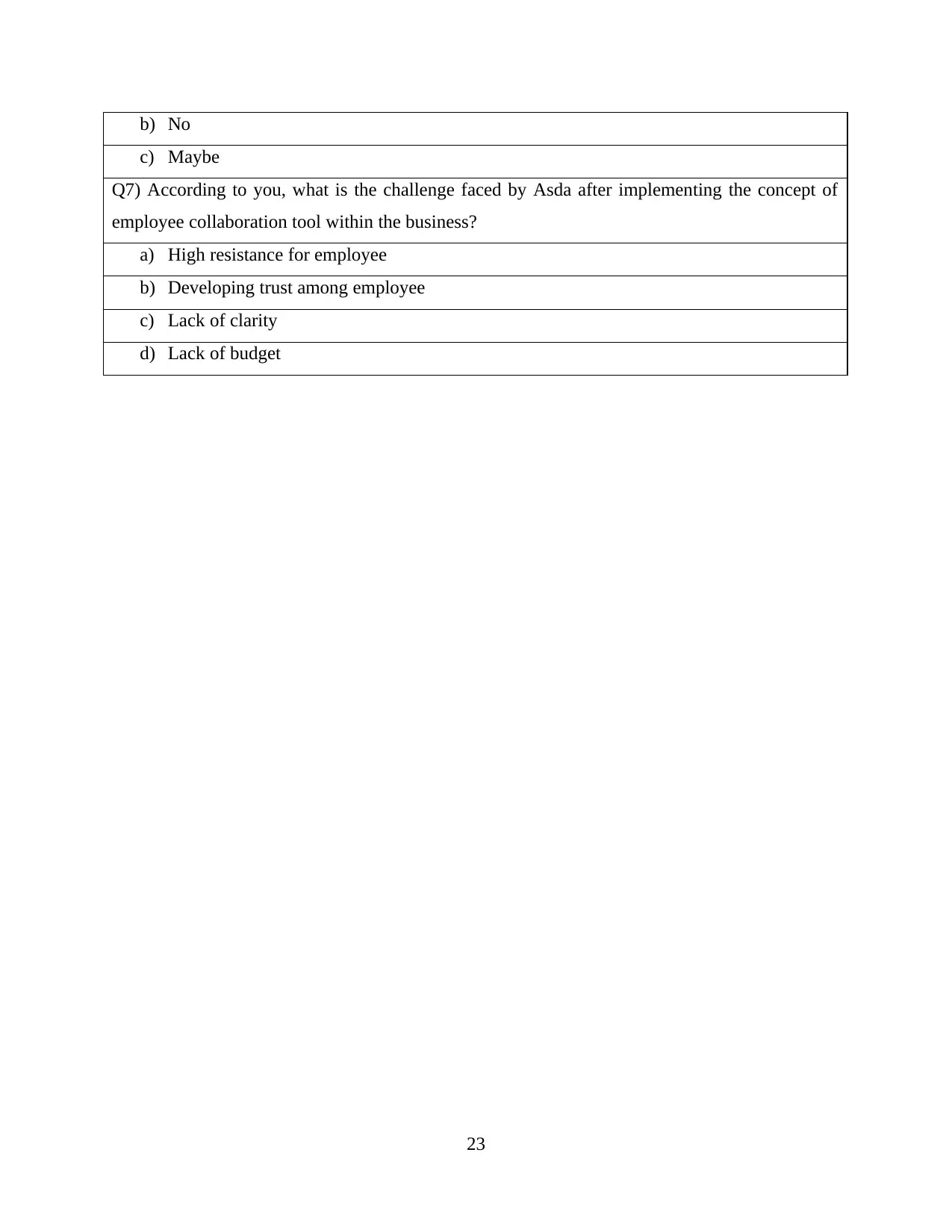
b) No
c) Maybe
Q7) According to you, what is the challenge faced by Asda after implementing the concept of
employee collaboration tool within the business?
a) High resistance for employee
b) Developing trust among employee
c) Lack of clarity
d) Lack of budget
23
c) Maybe
Q7) According to you, what is the challenge faced by Asda after implementing the concept of
employee collaboration tool within the business?
a) High resistance for employee
b) Developing trust among employee
c) Lack of clarity
d) Lack of budget
23
1 out of 23
Related Documents
Your All-in-One AI-Powered Toolkit for Academic Success.
+13062052269
info@desklib.com
Available 24*7 on WhatsApp / Email
![[object Object]](/_next/static/media/star-bottom.7253800d.svg)
Unlock your academic potential
© 2024 | Zucol Services PVT LTD | All rights reserved.



